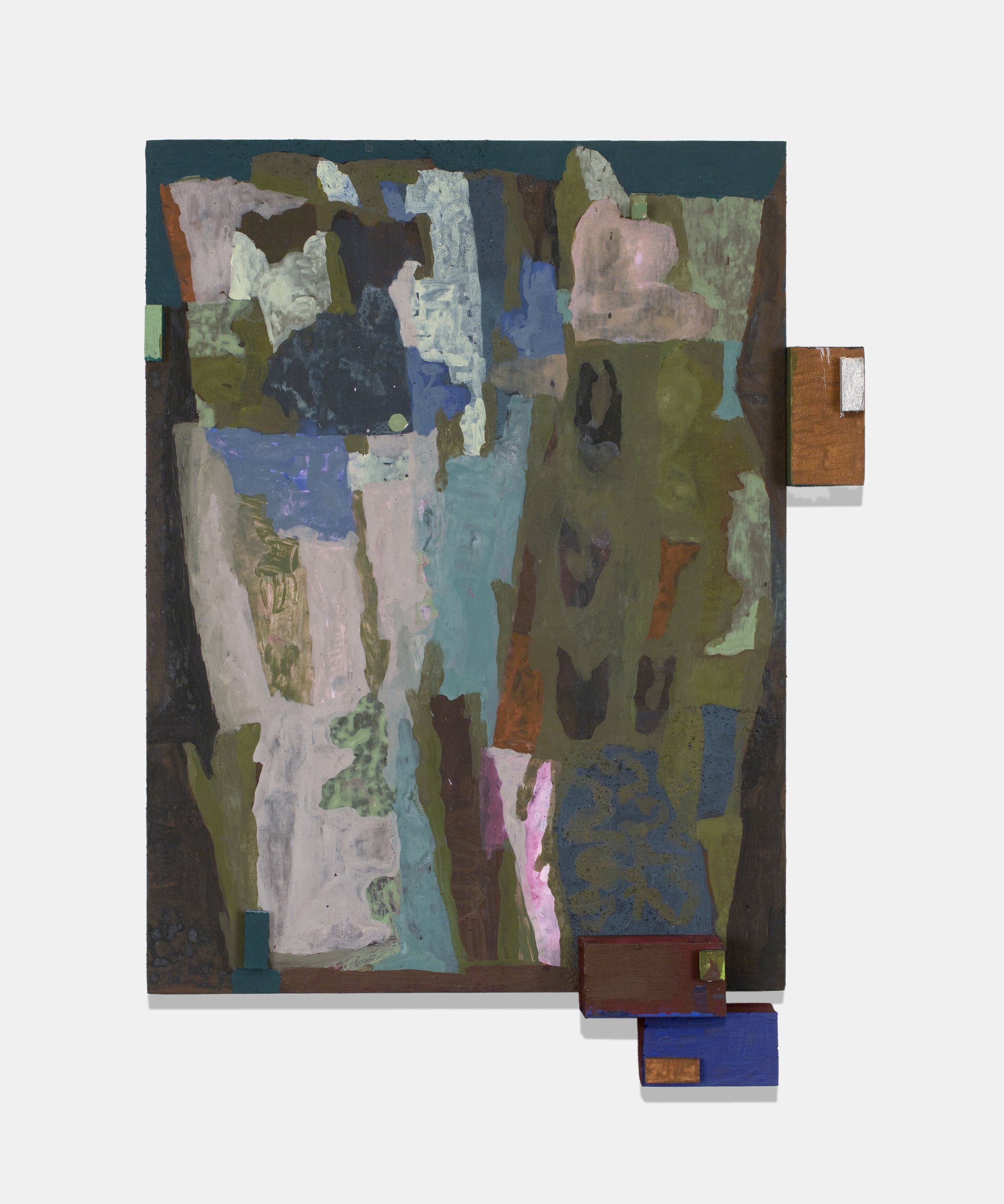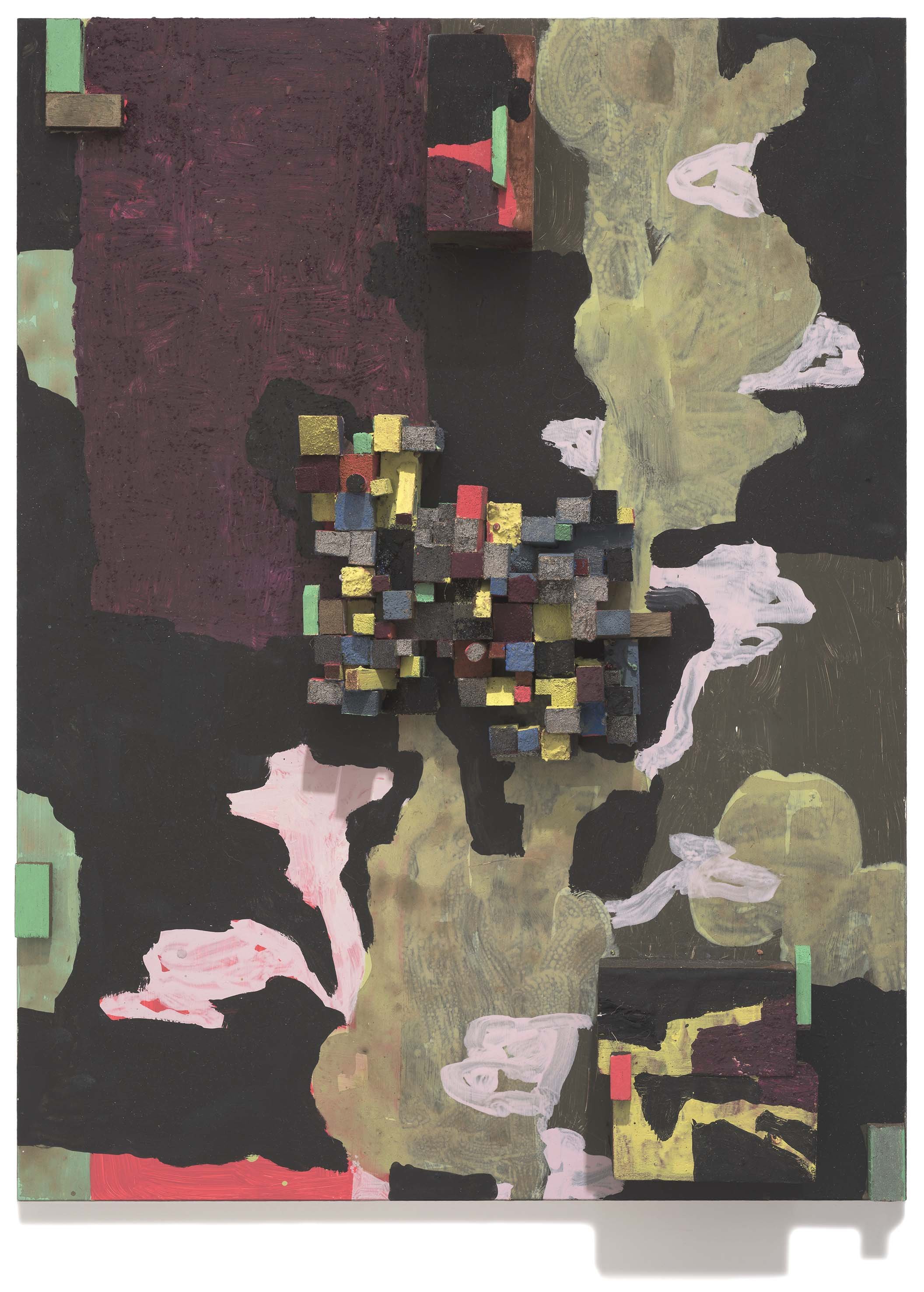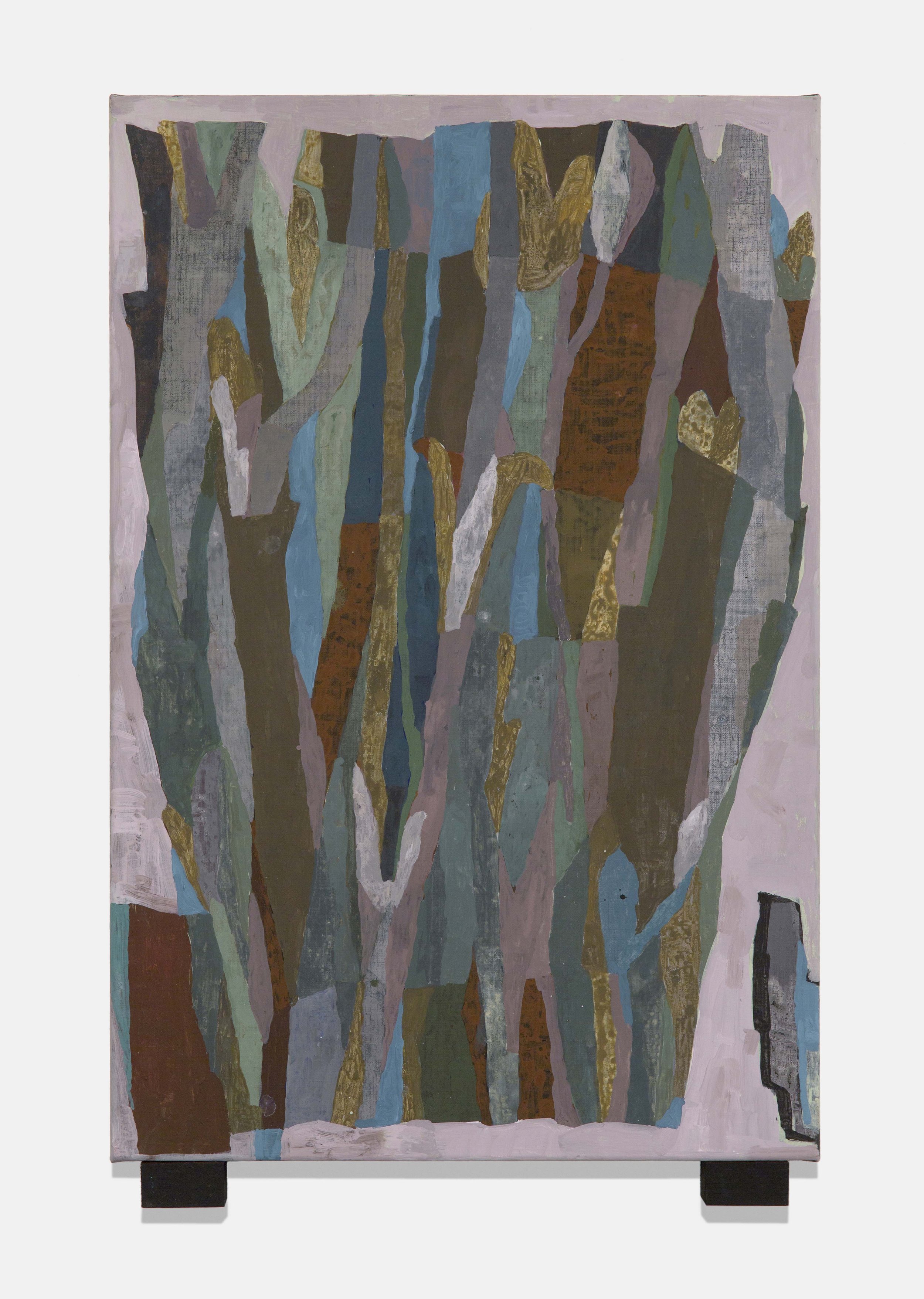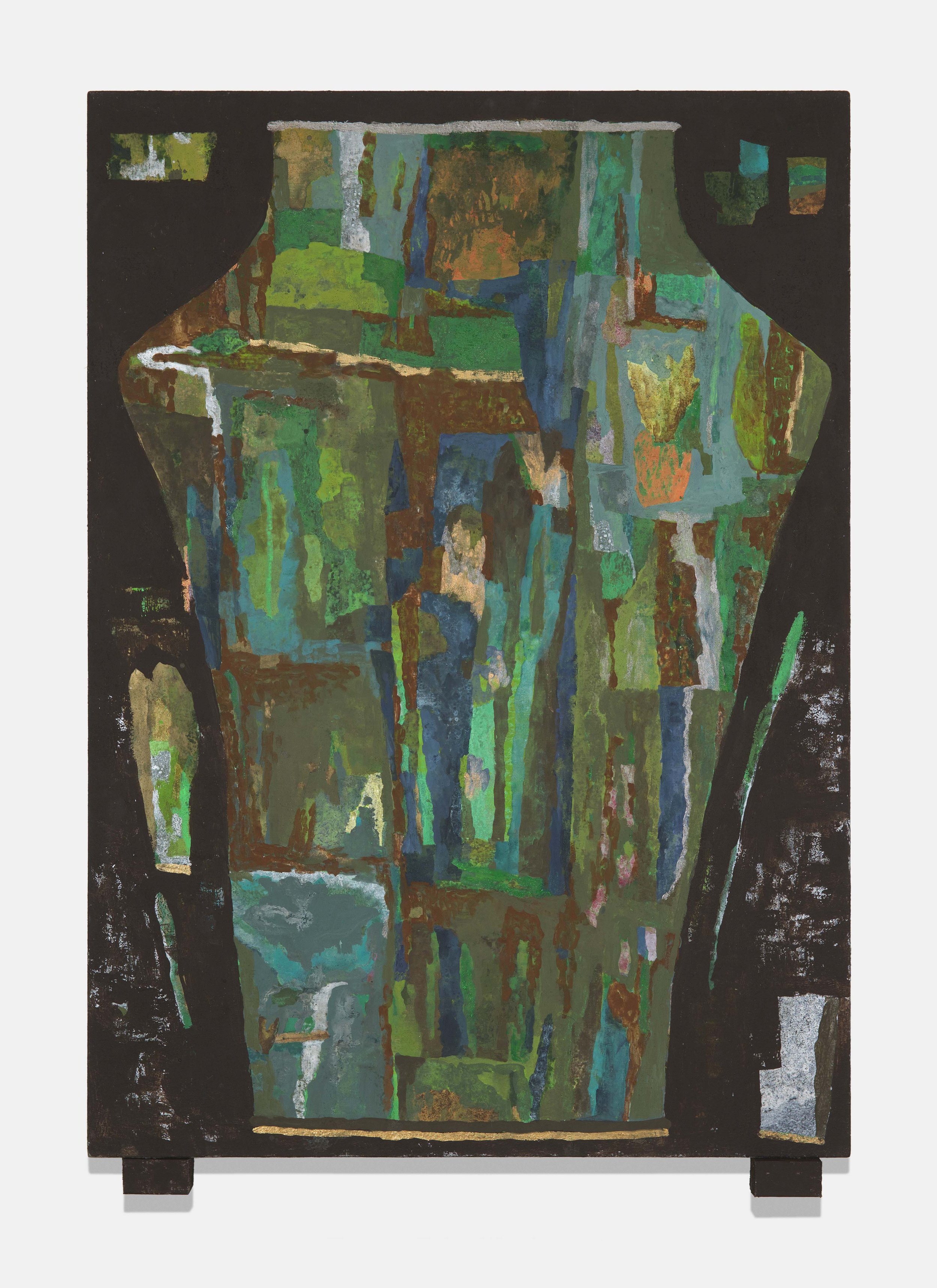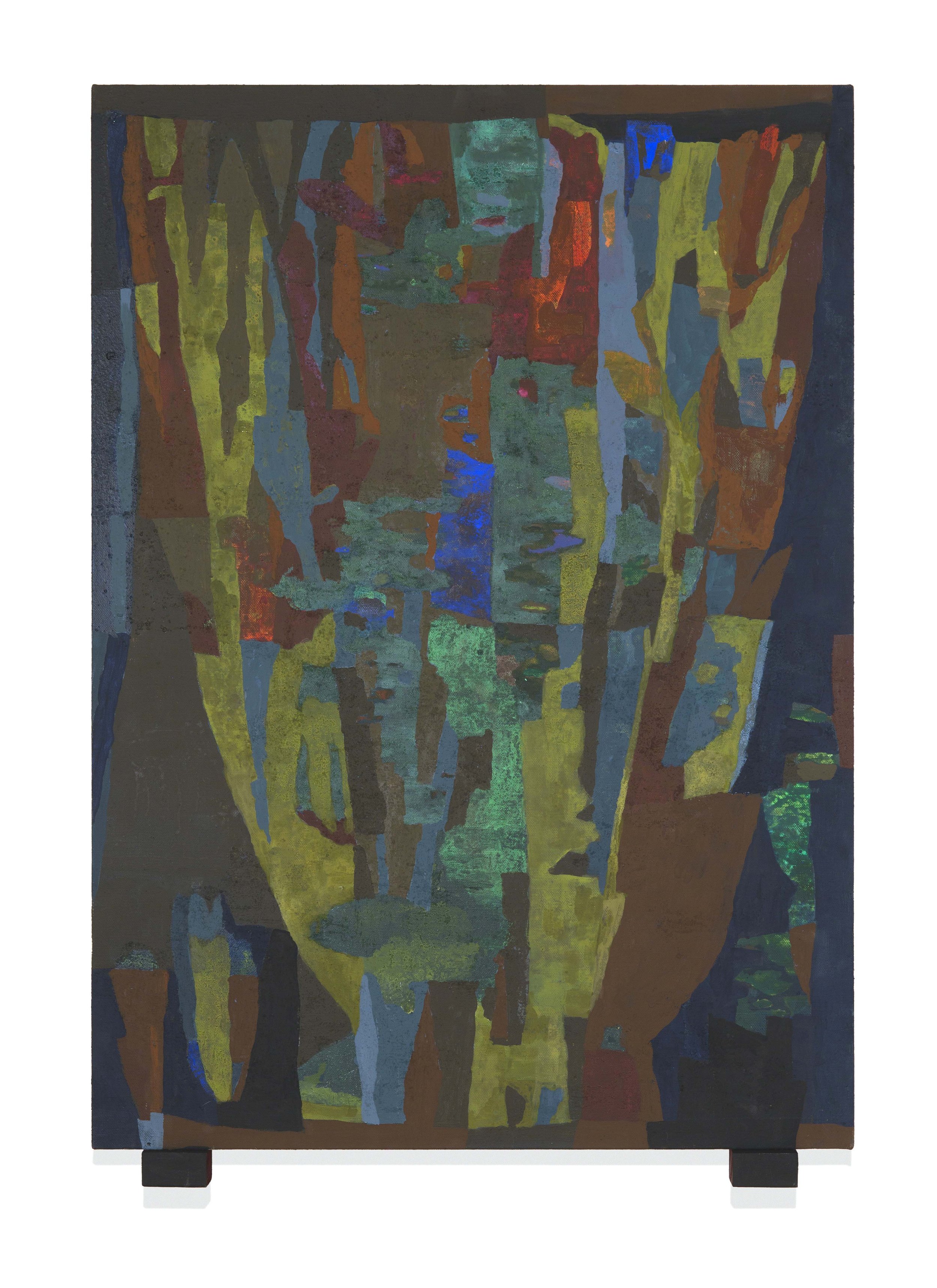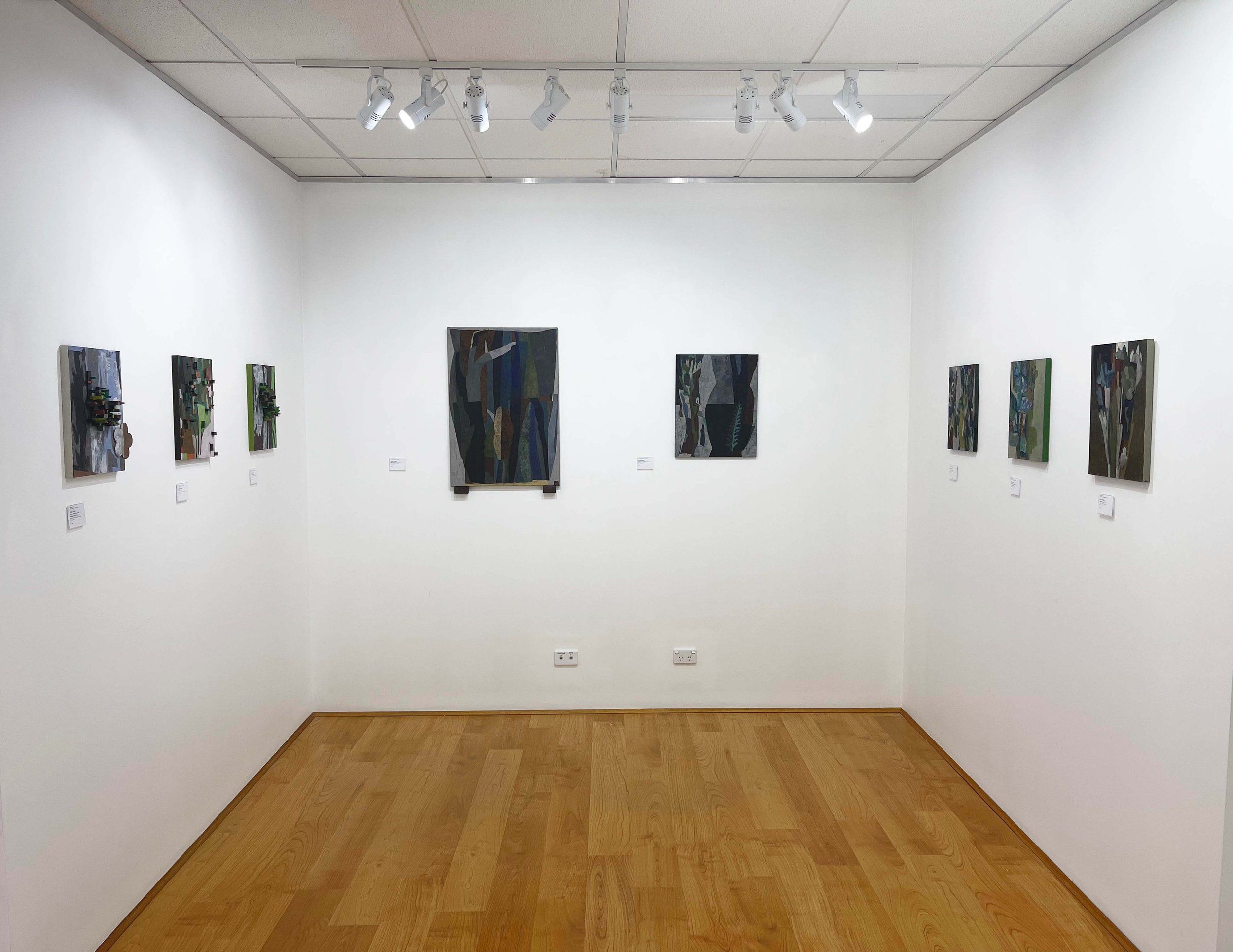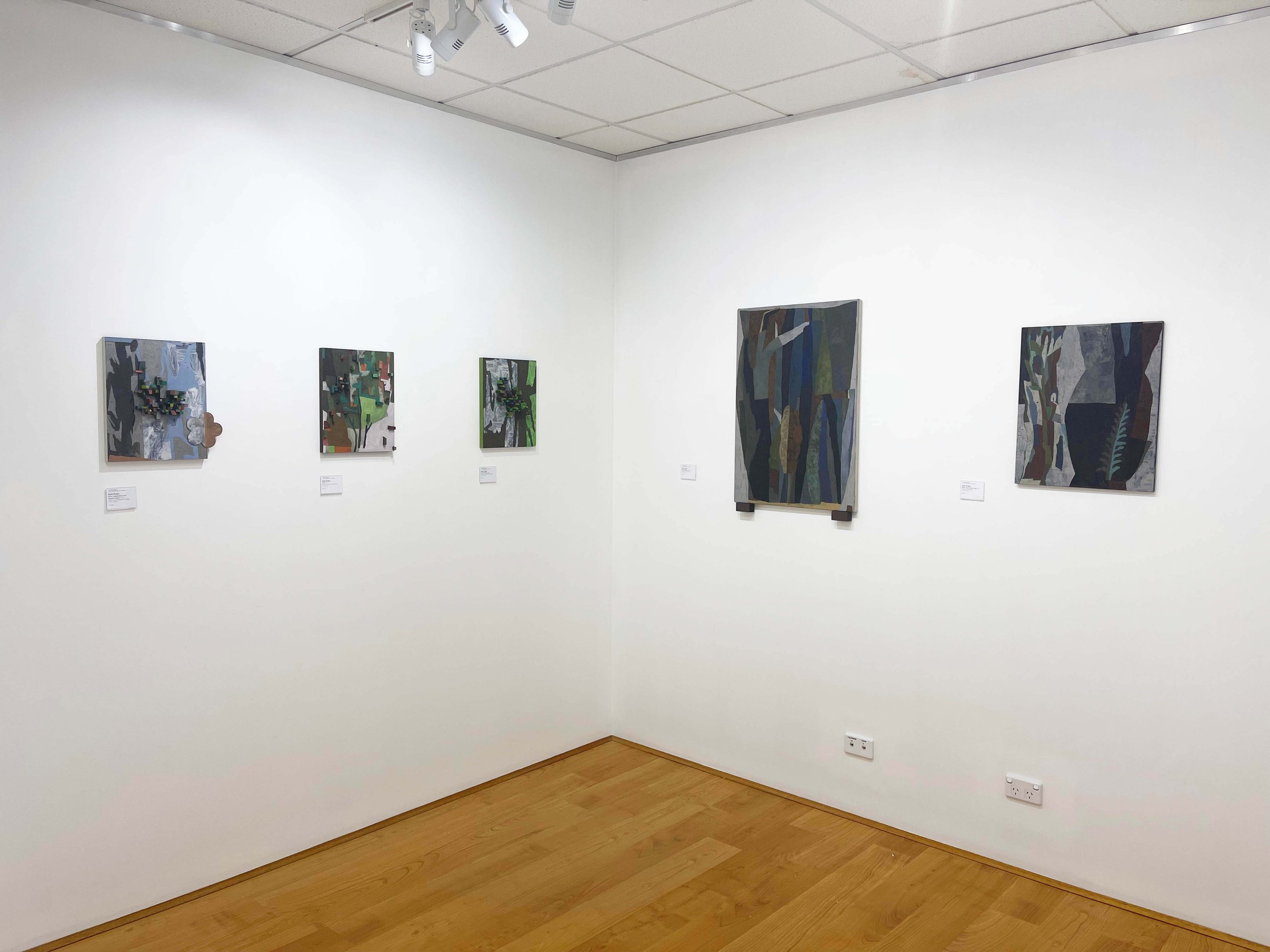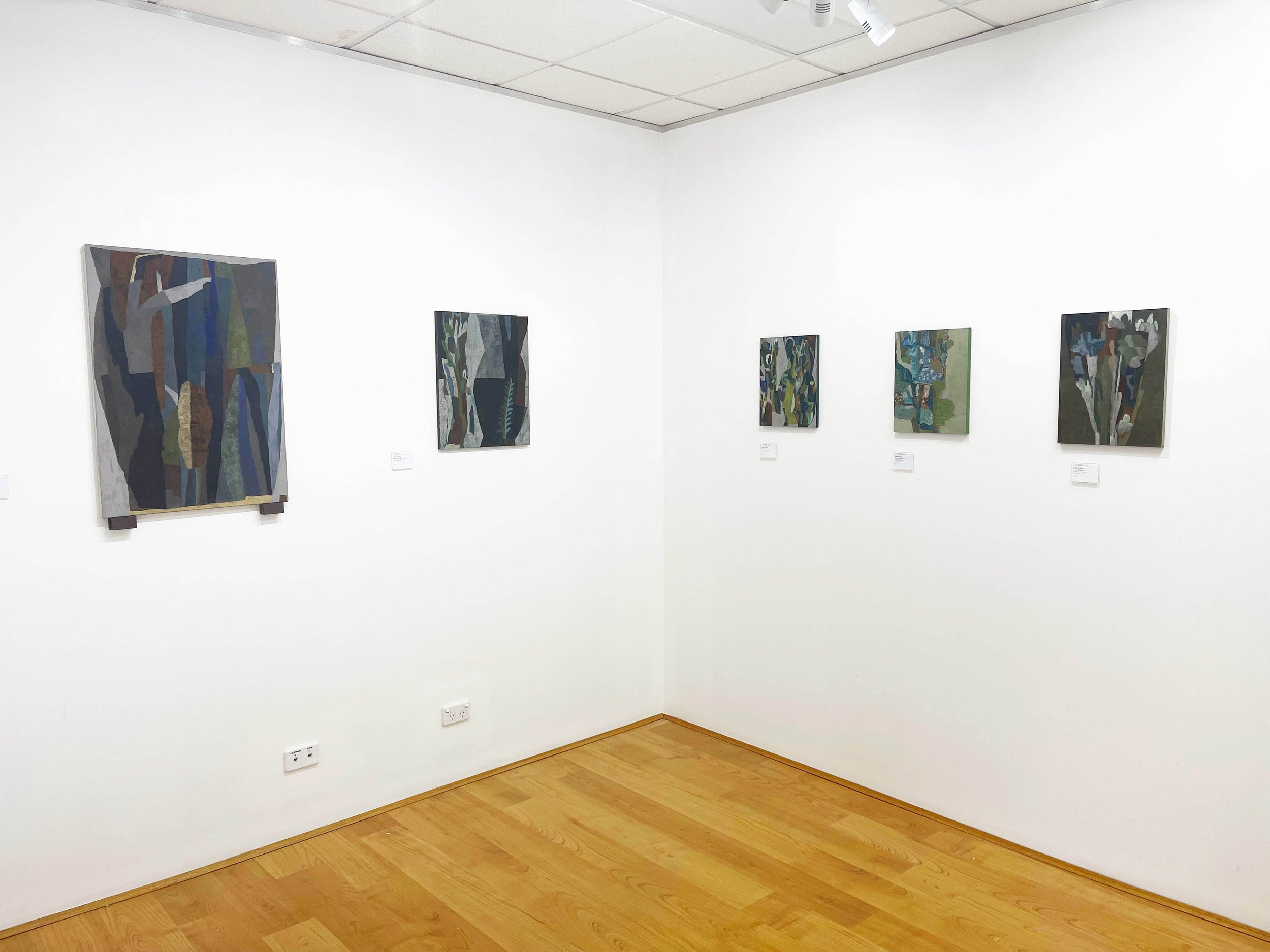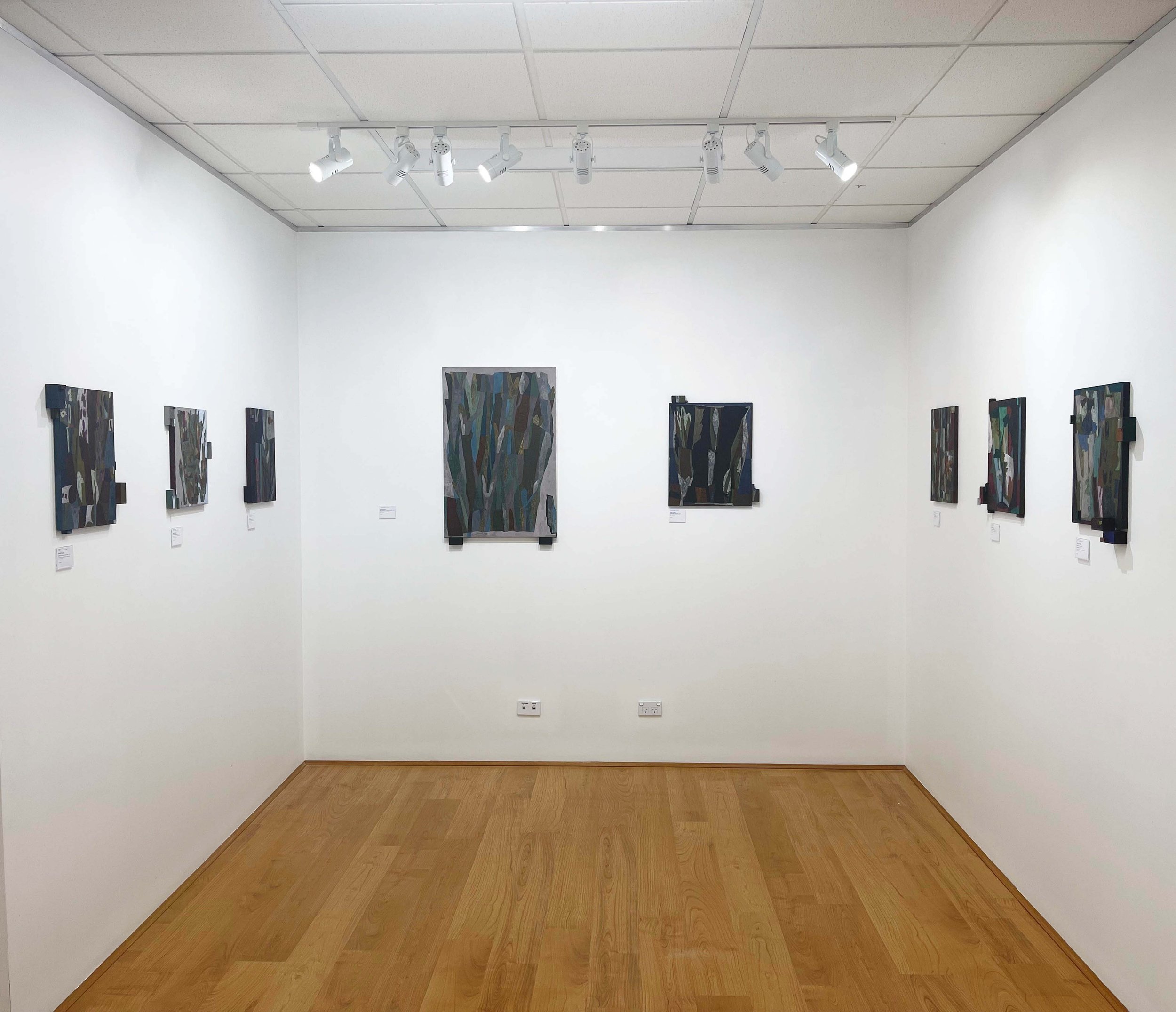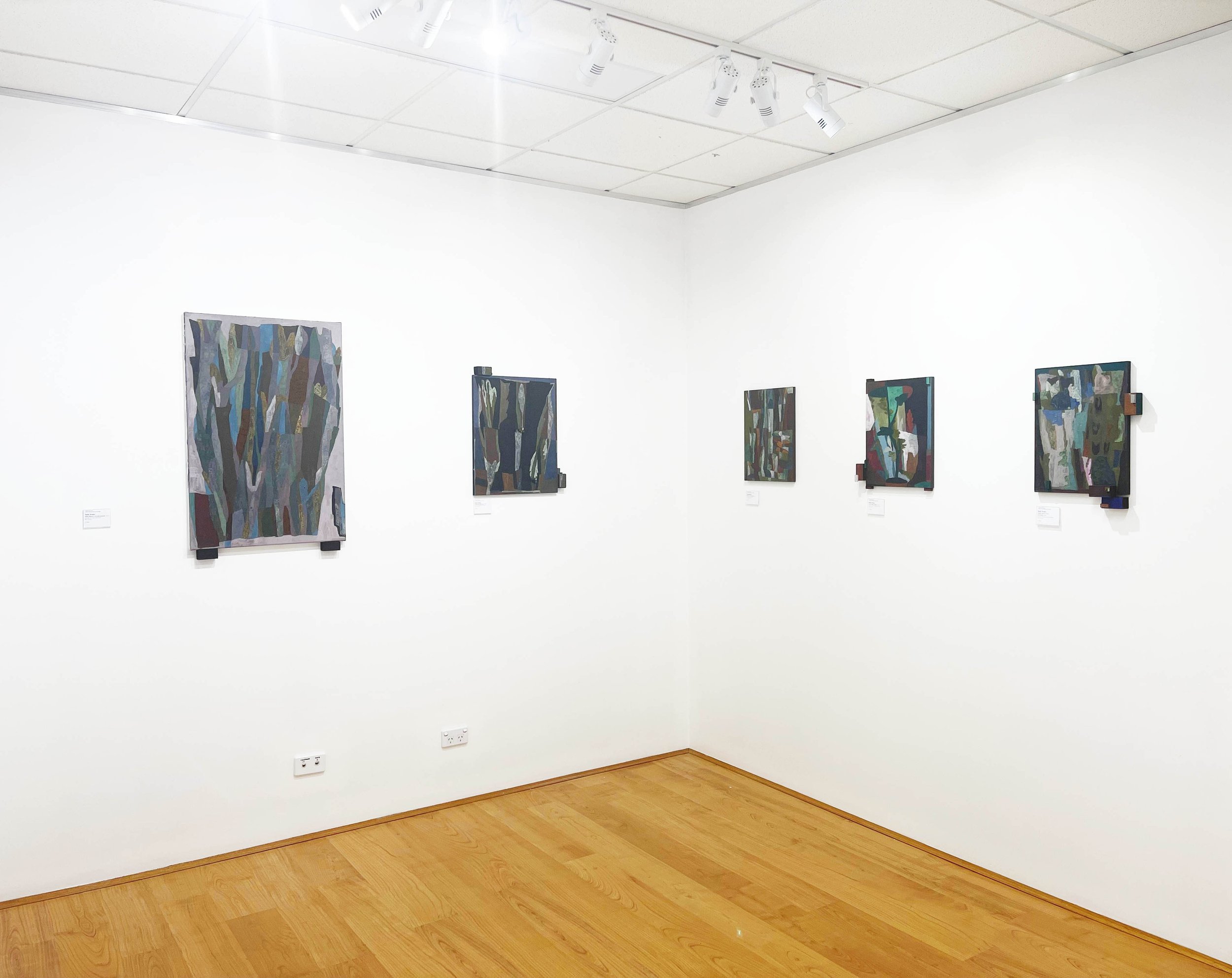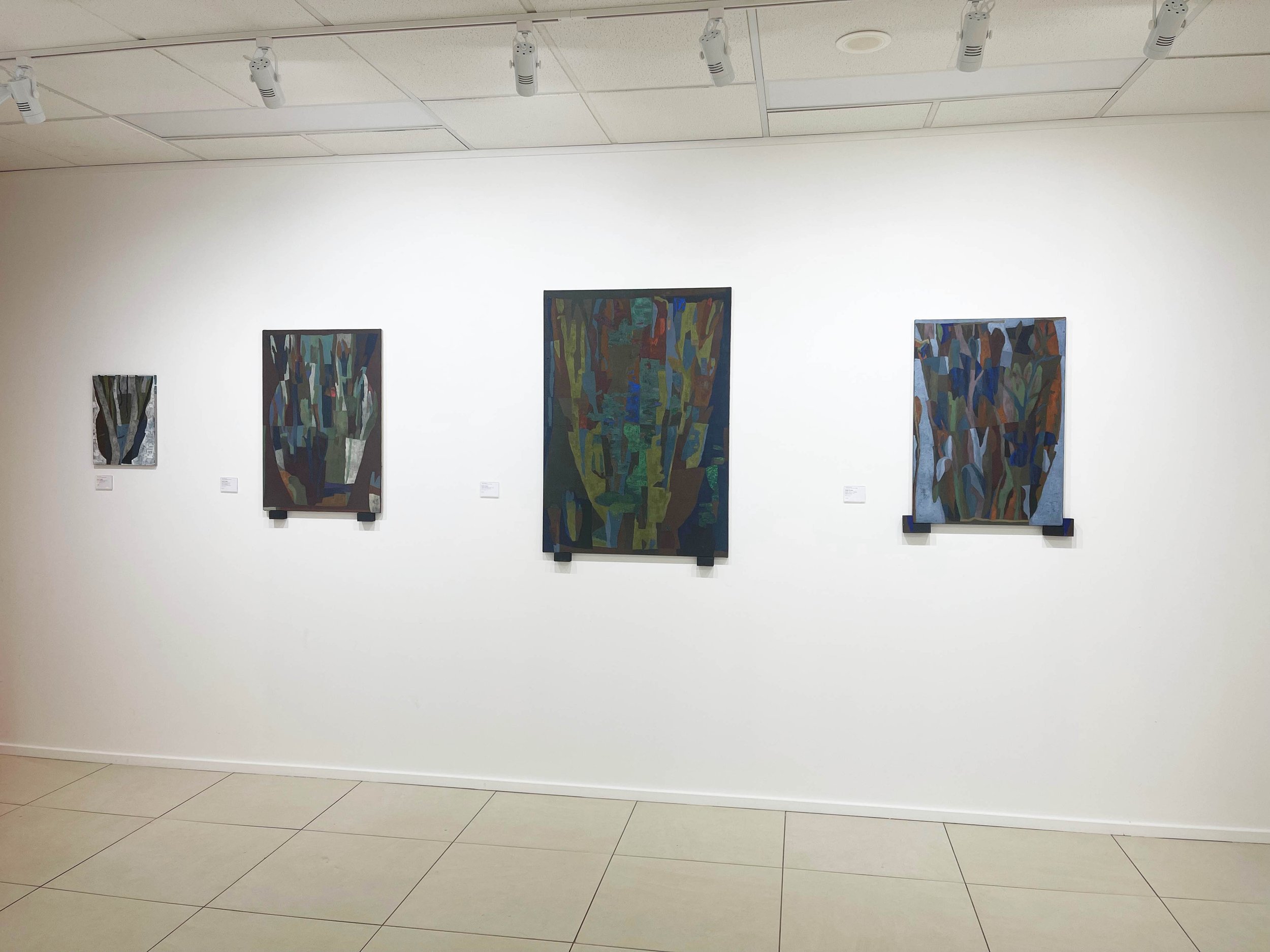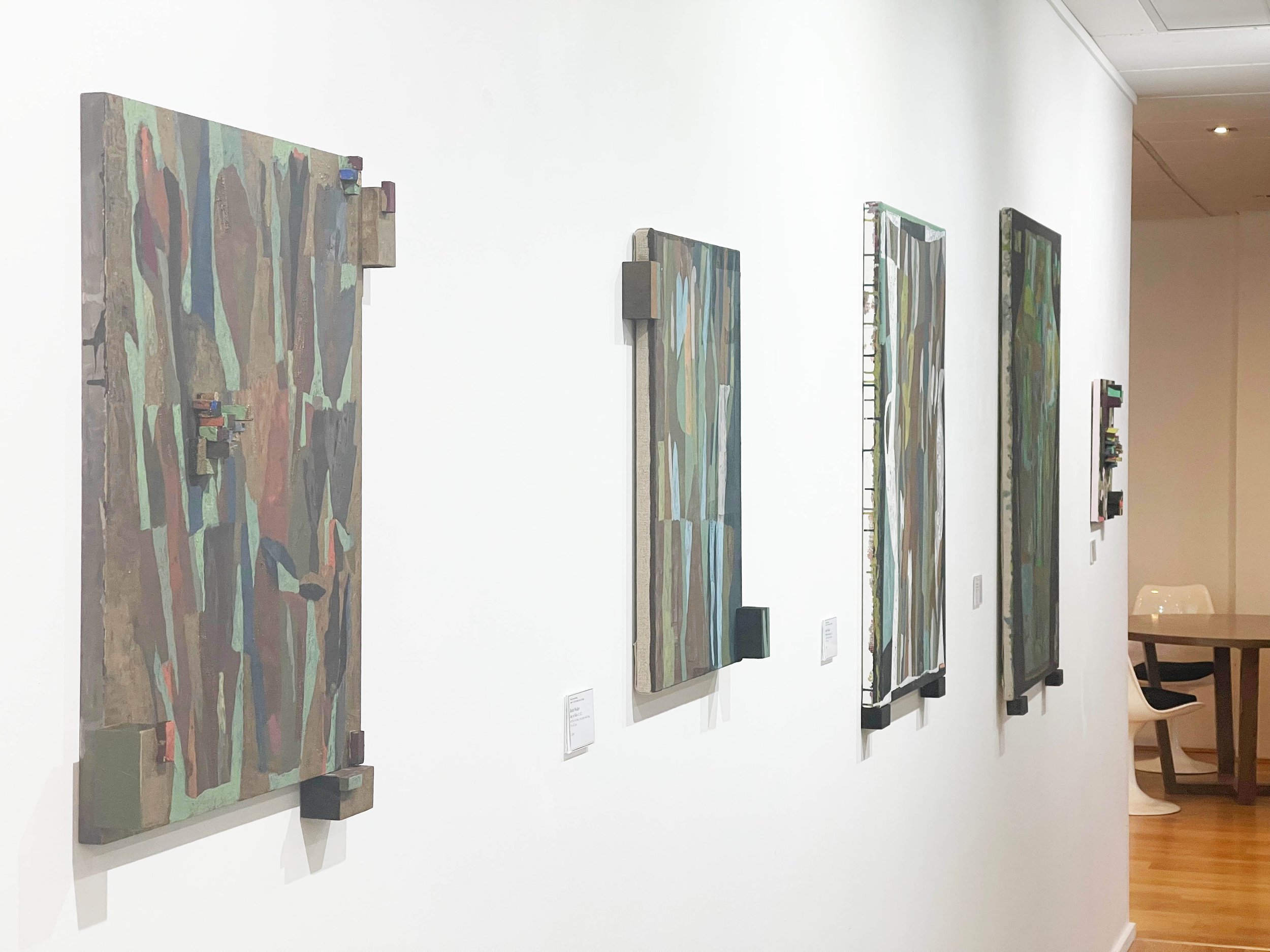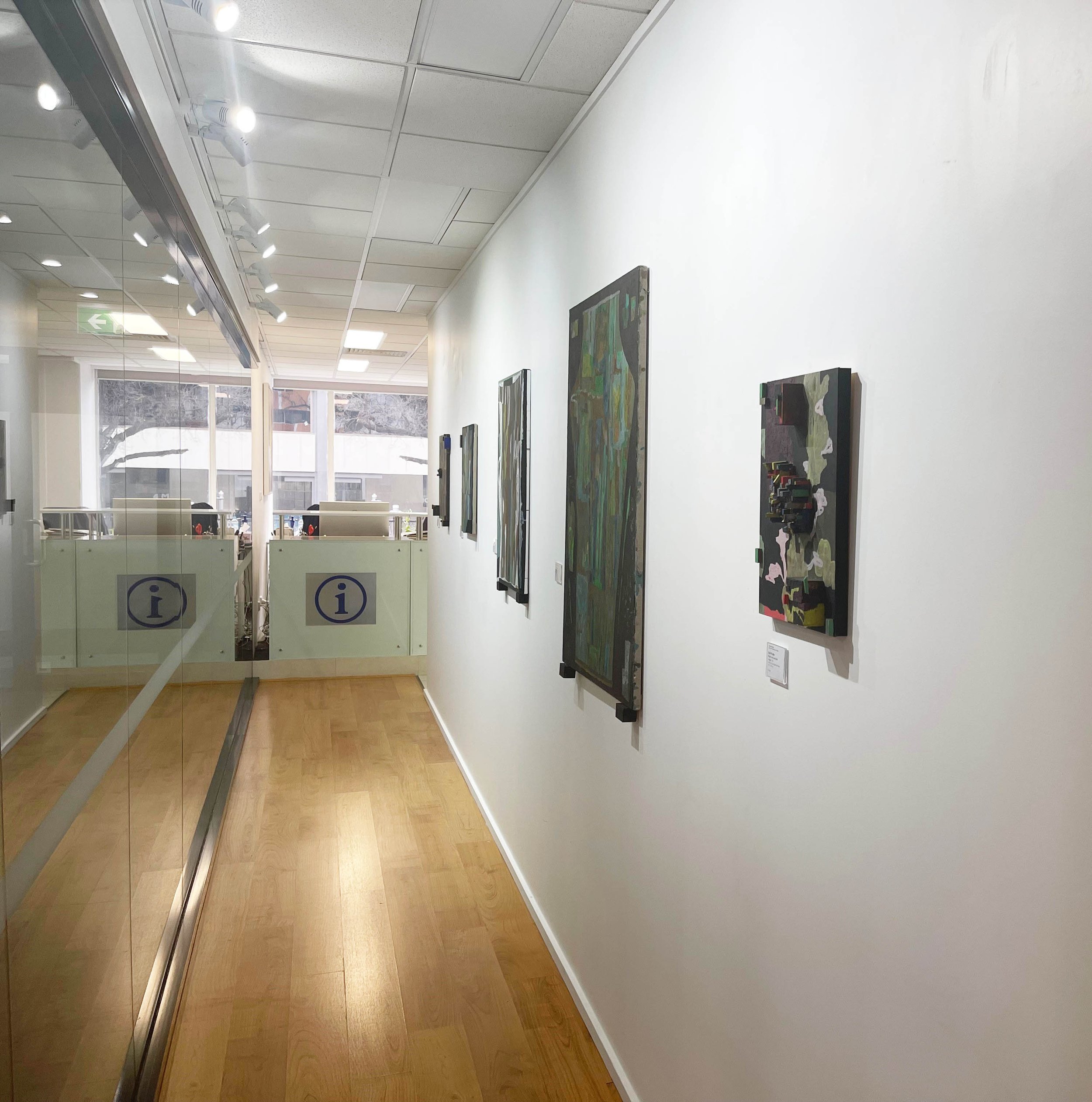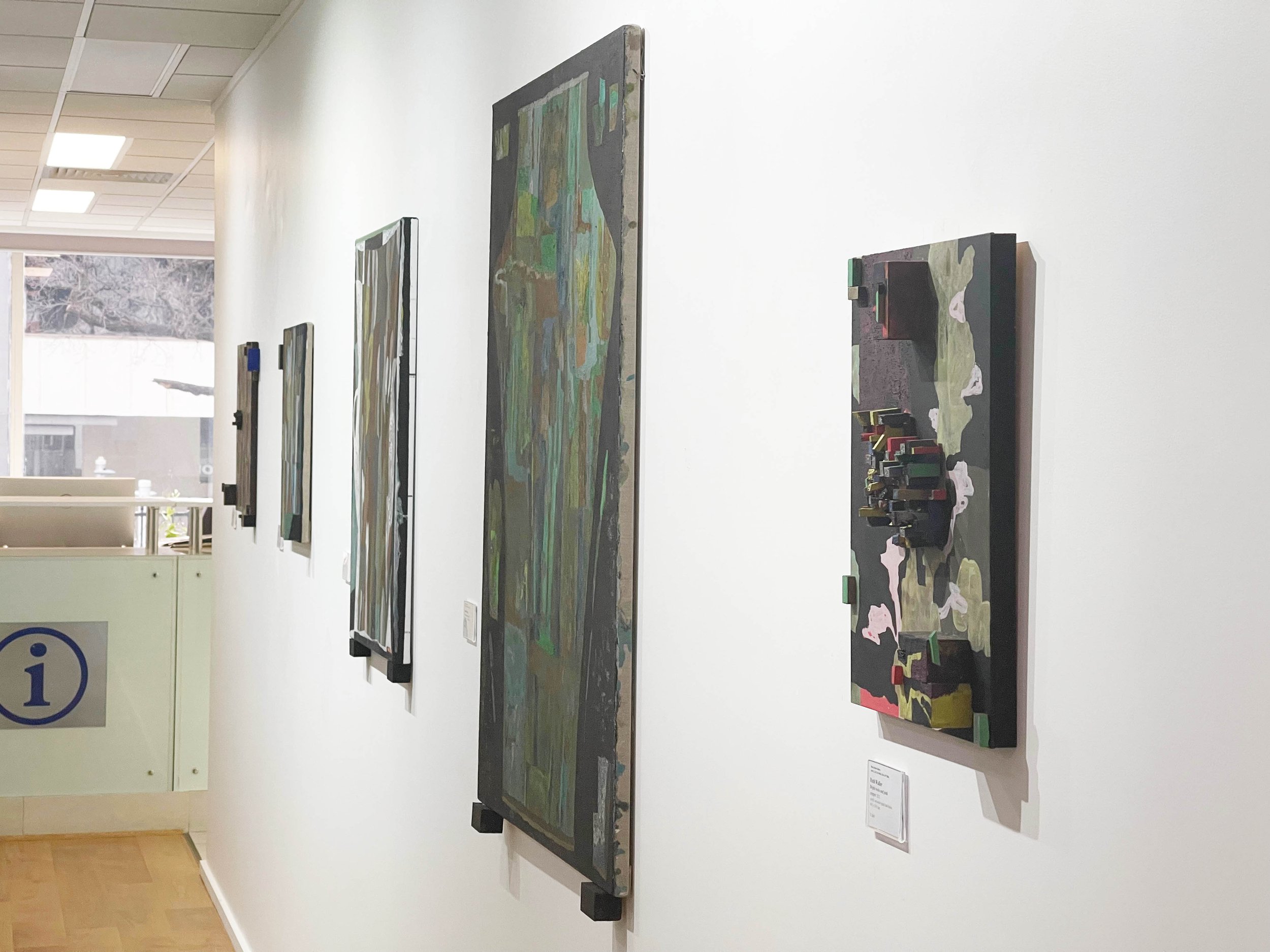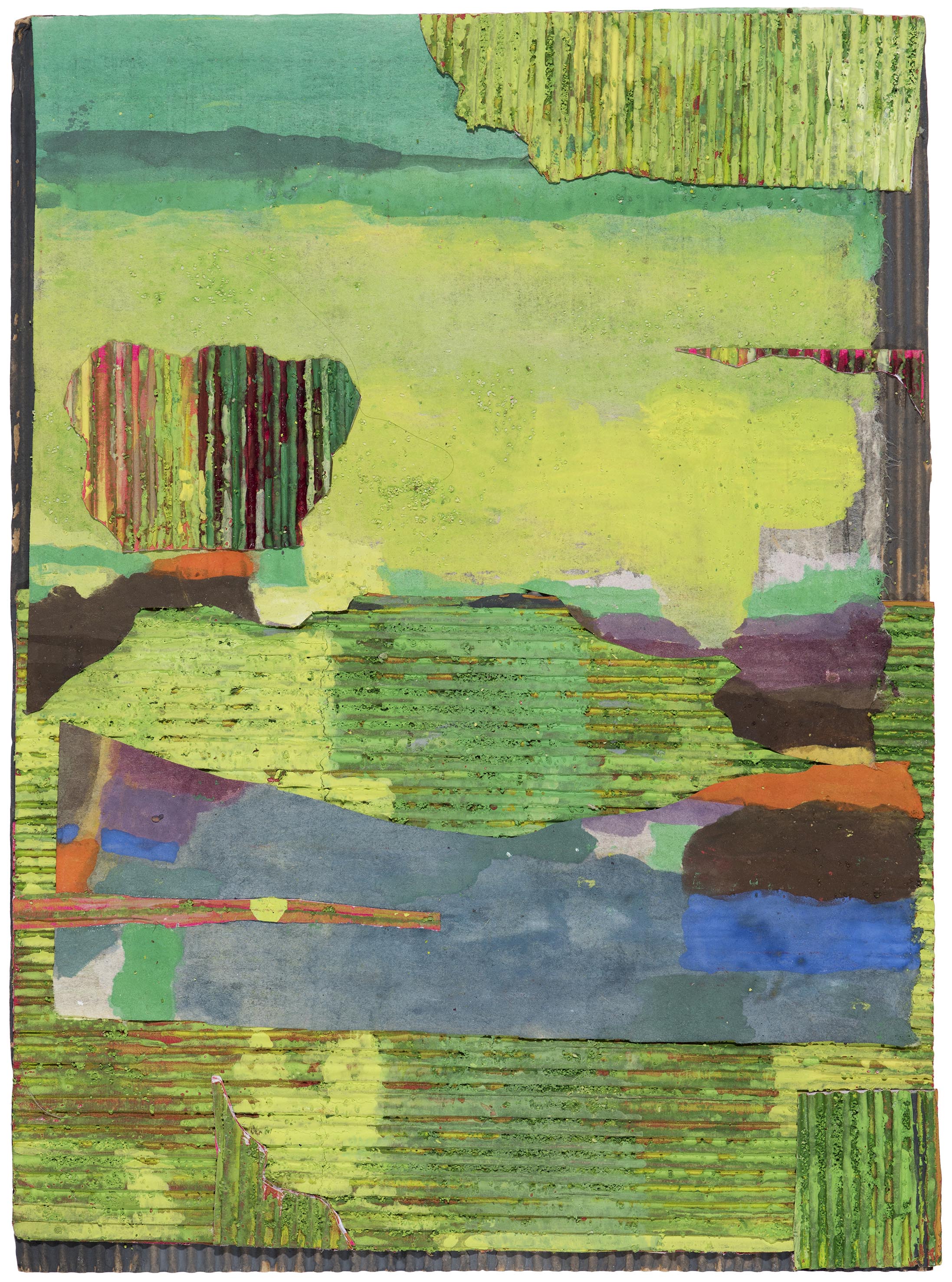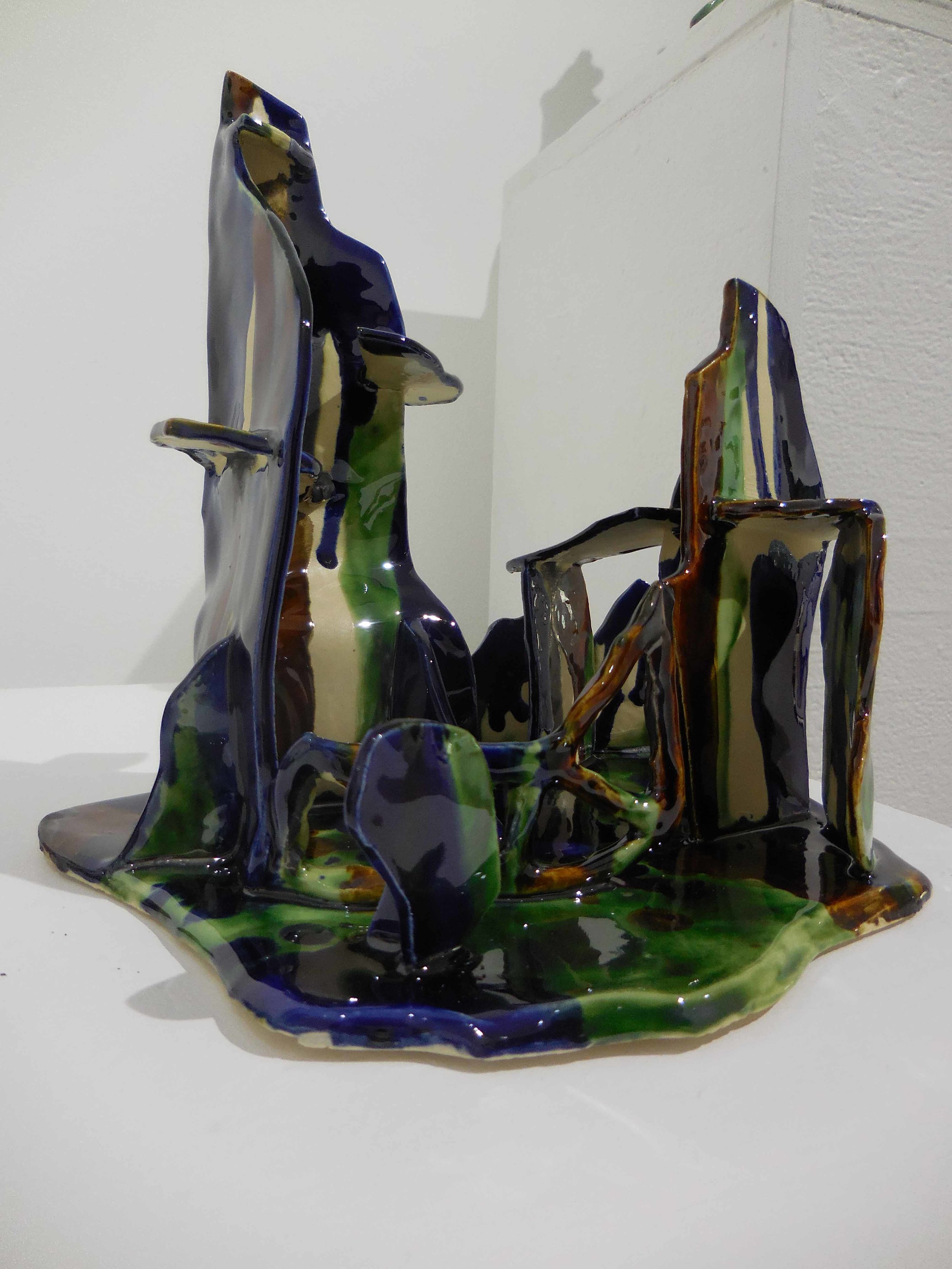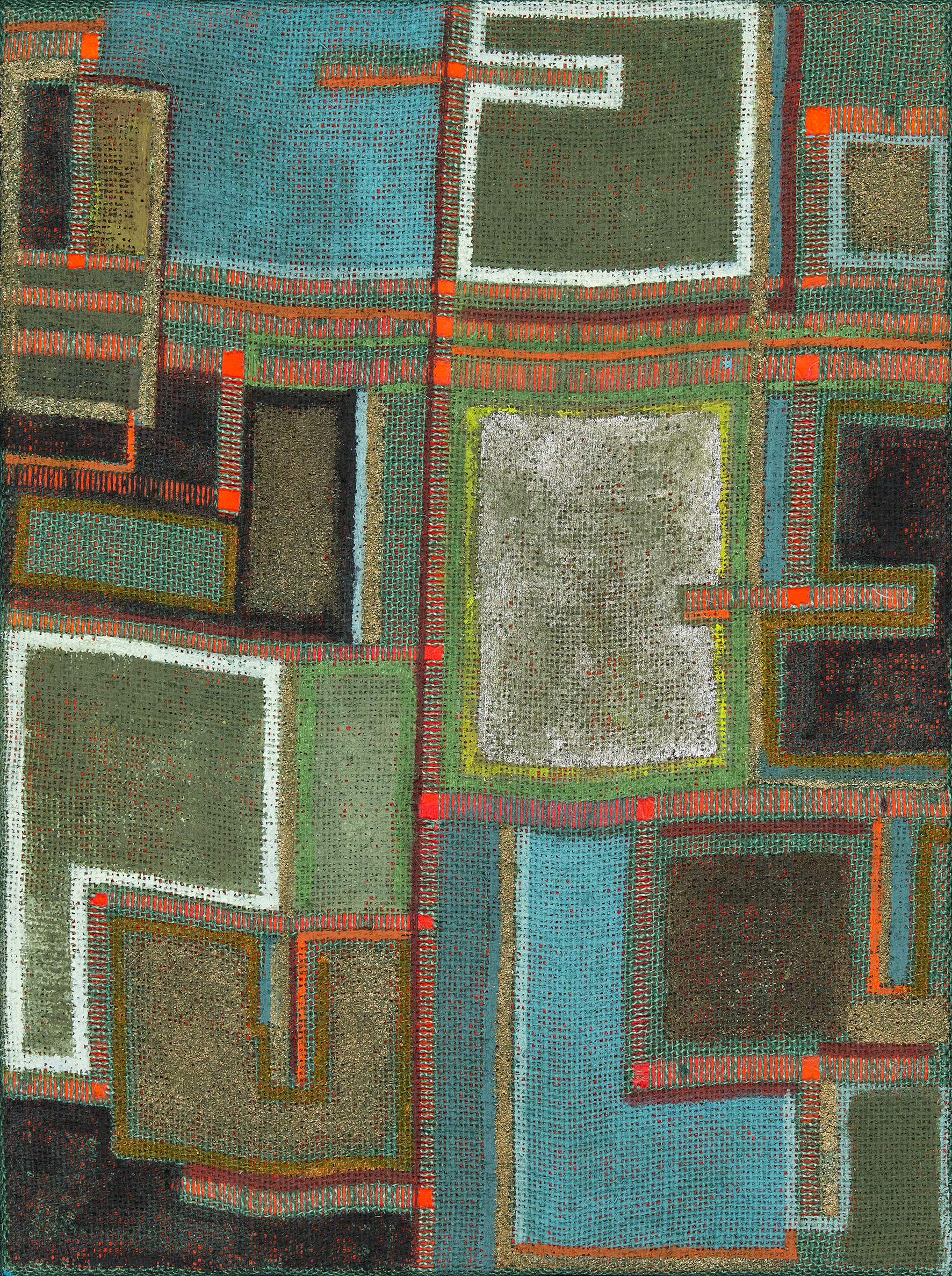Works in the exhibition
(for details of the works, please click on work and hold cursor over the image)
Views of the exhibition

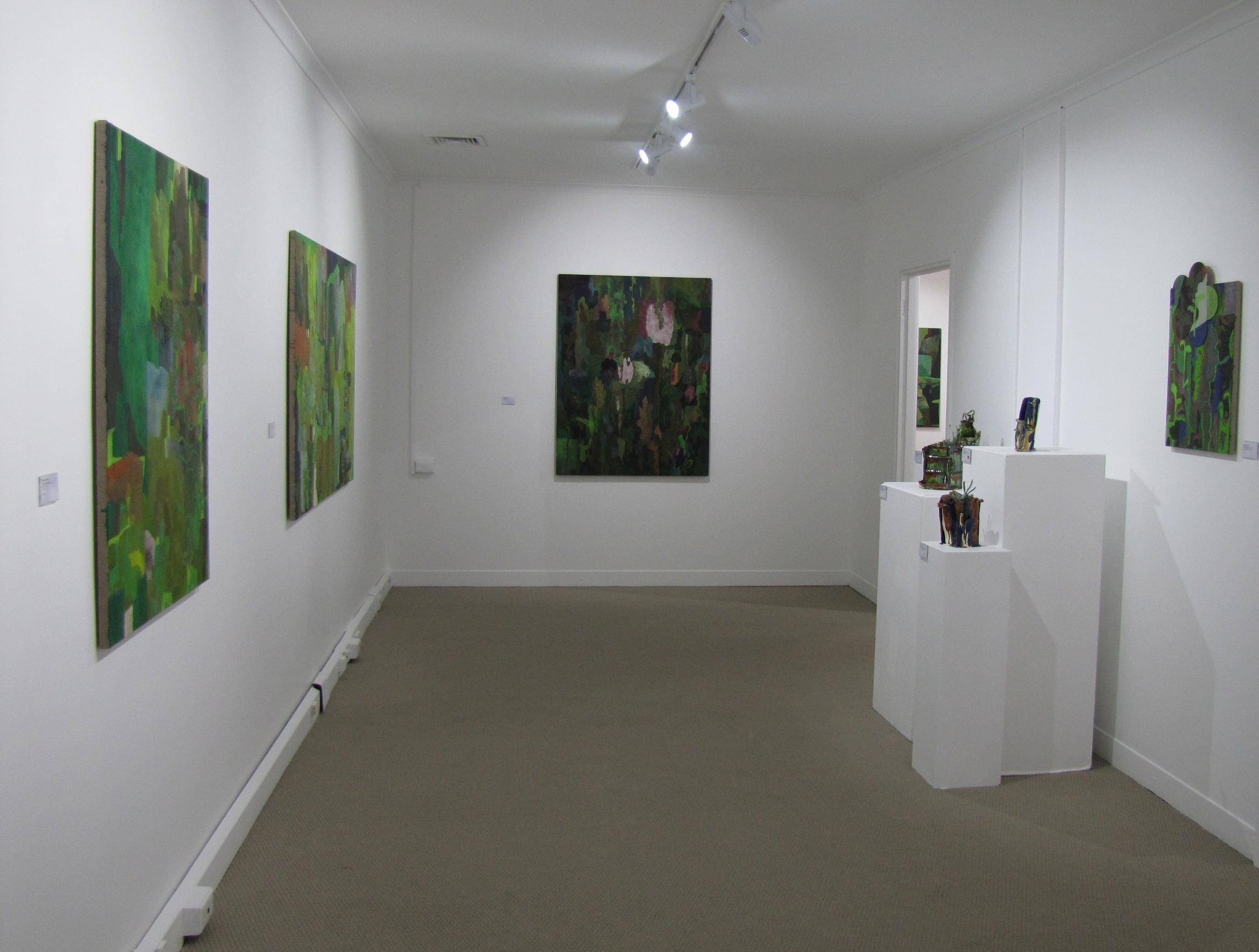
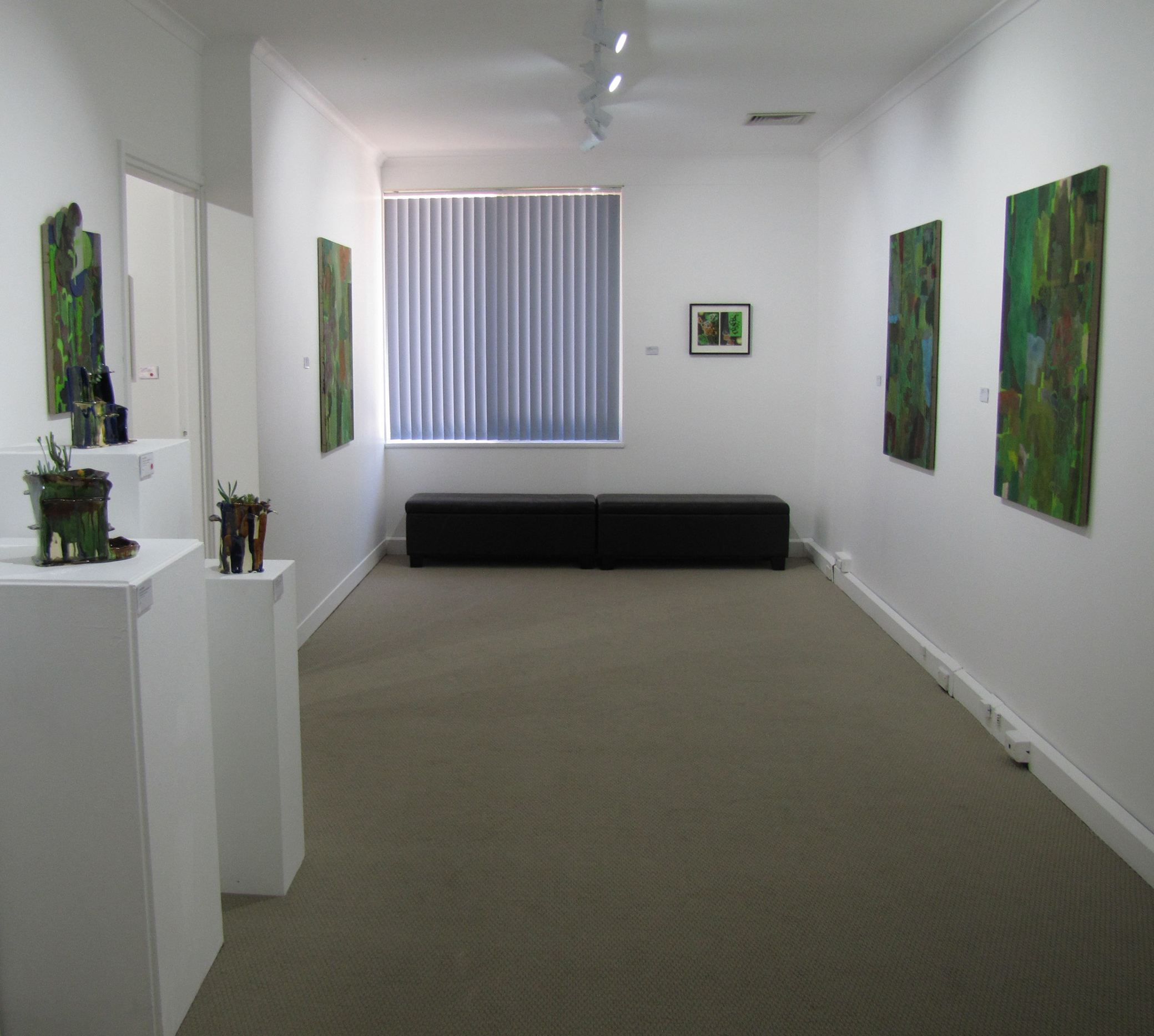
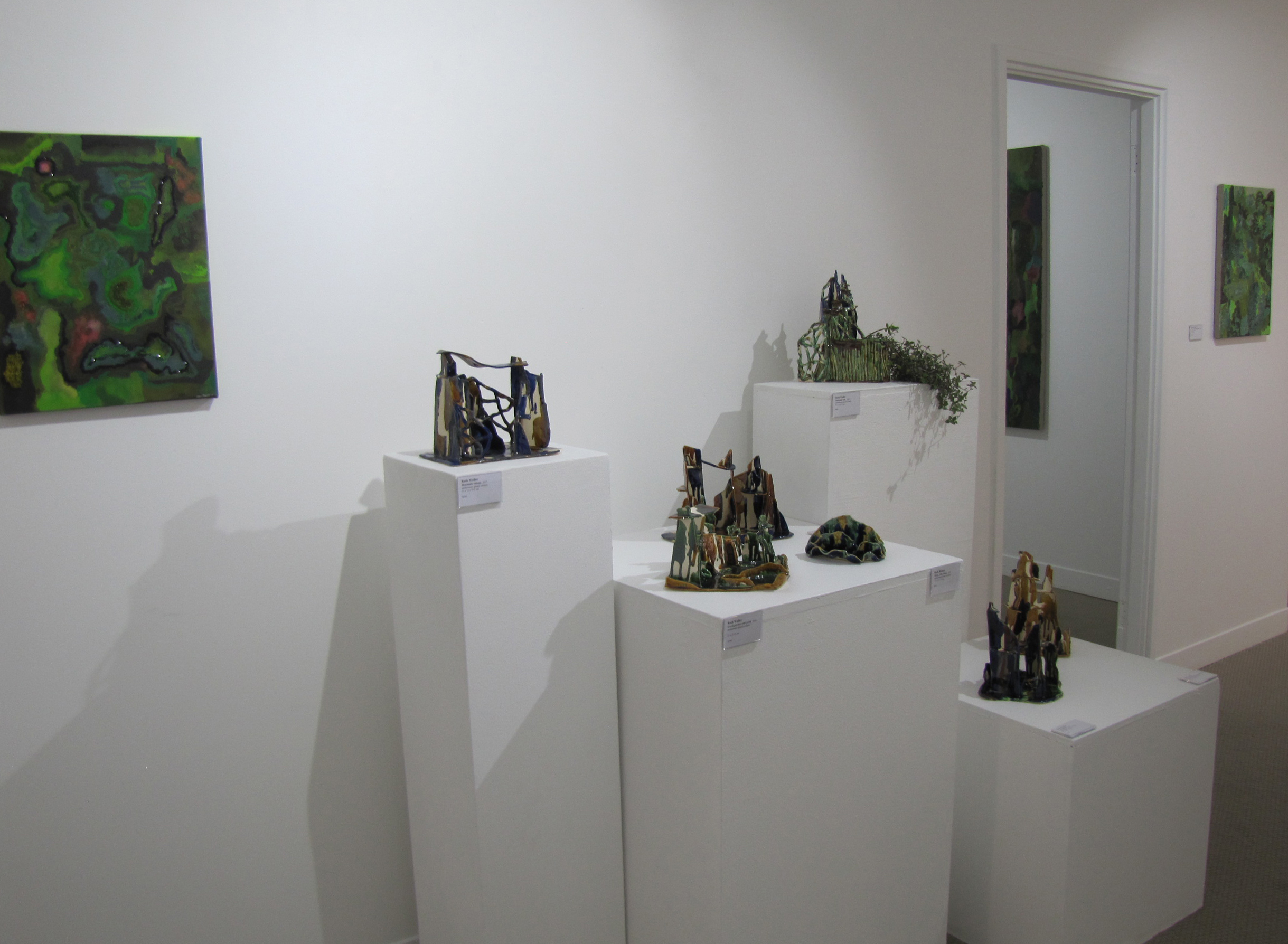
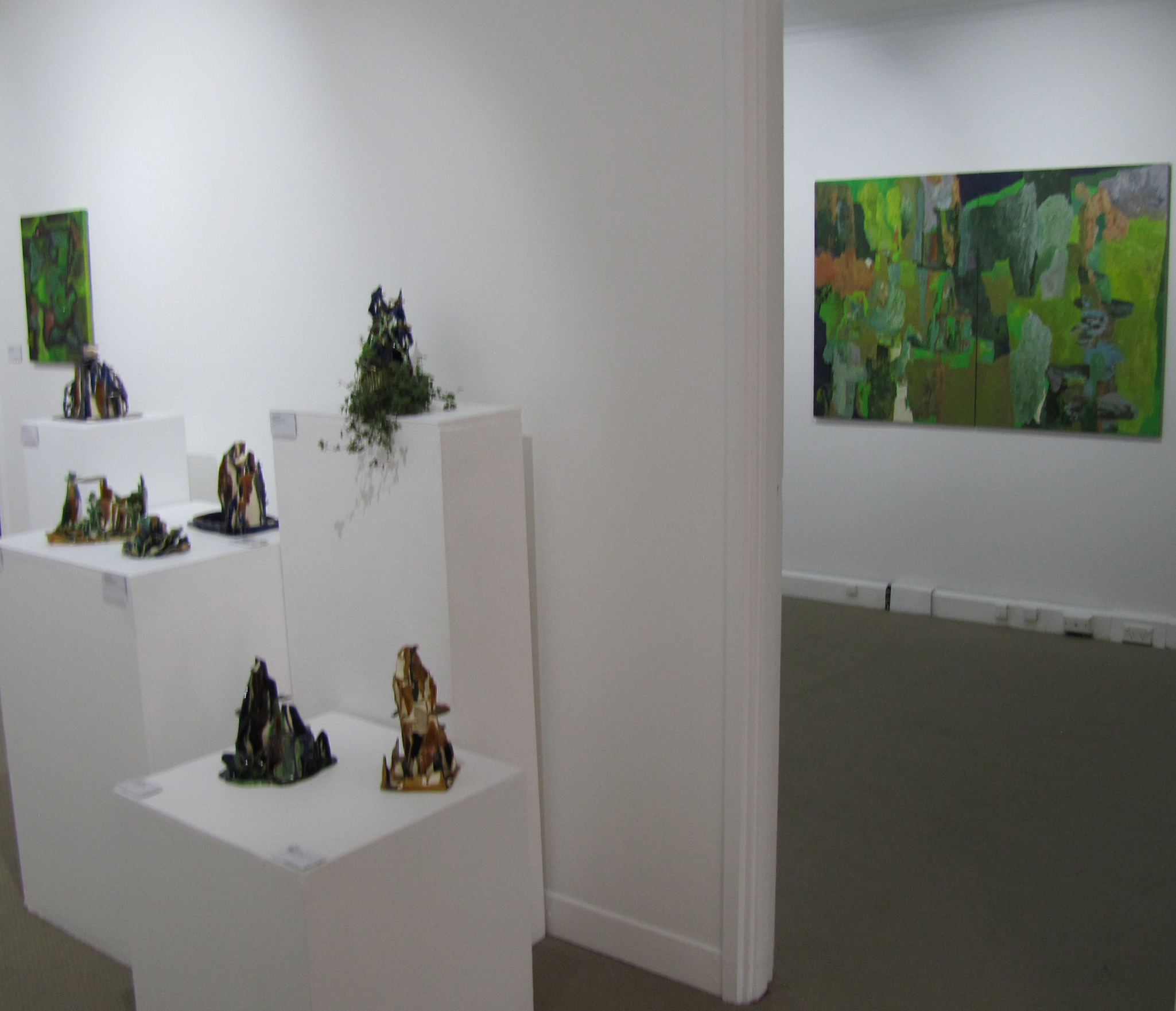
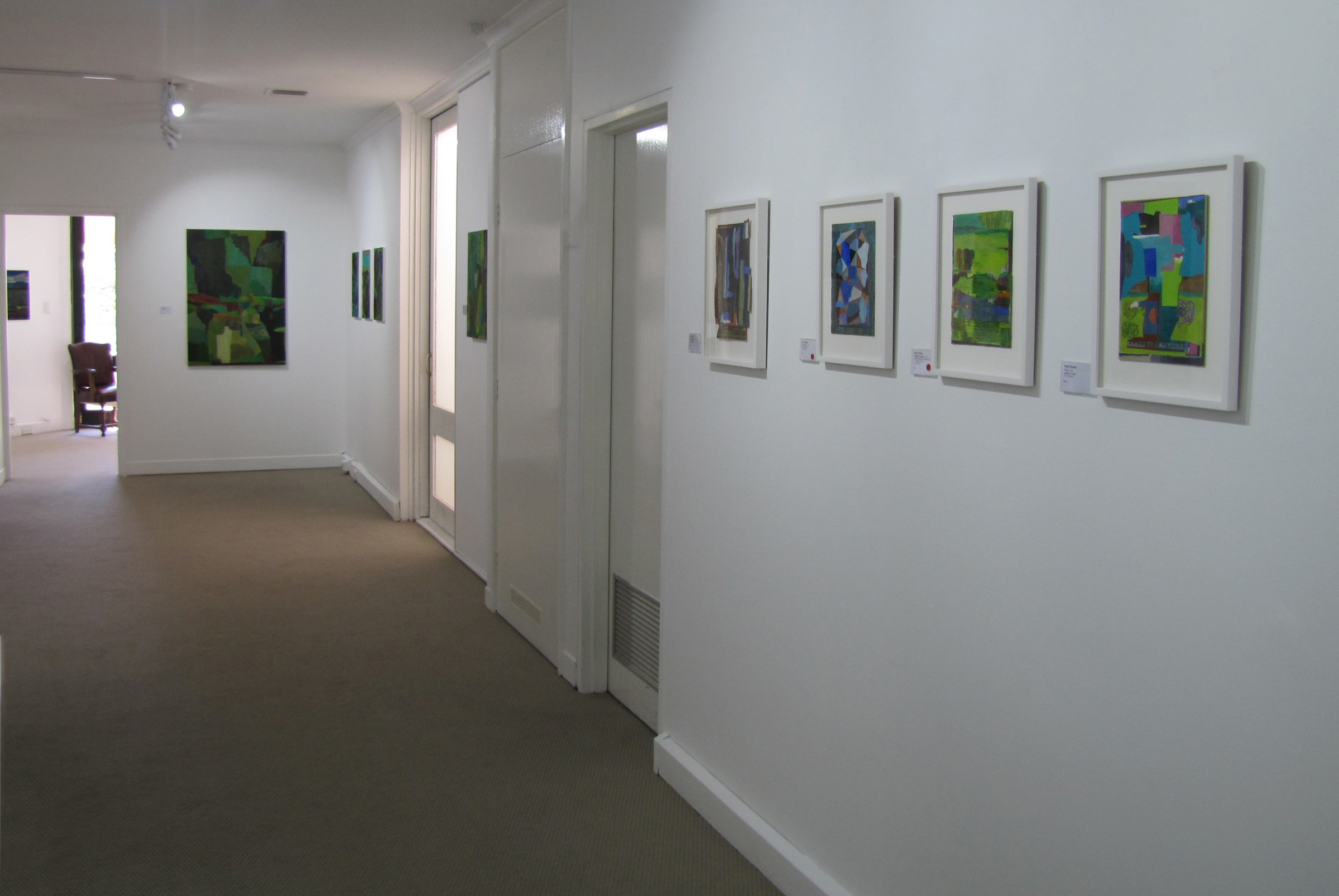
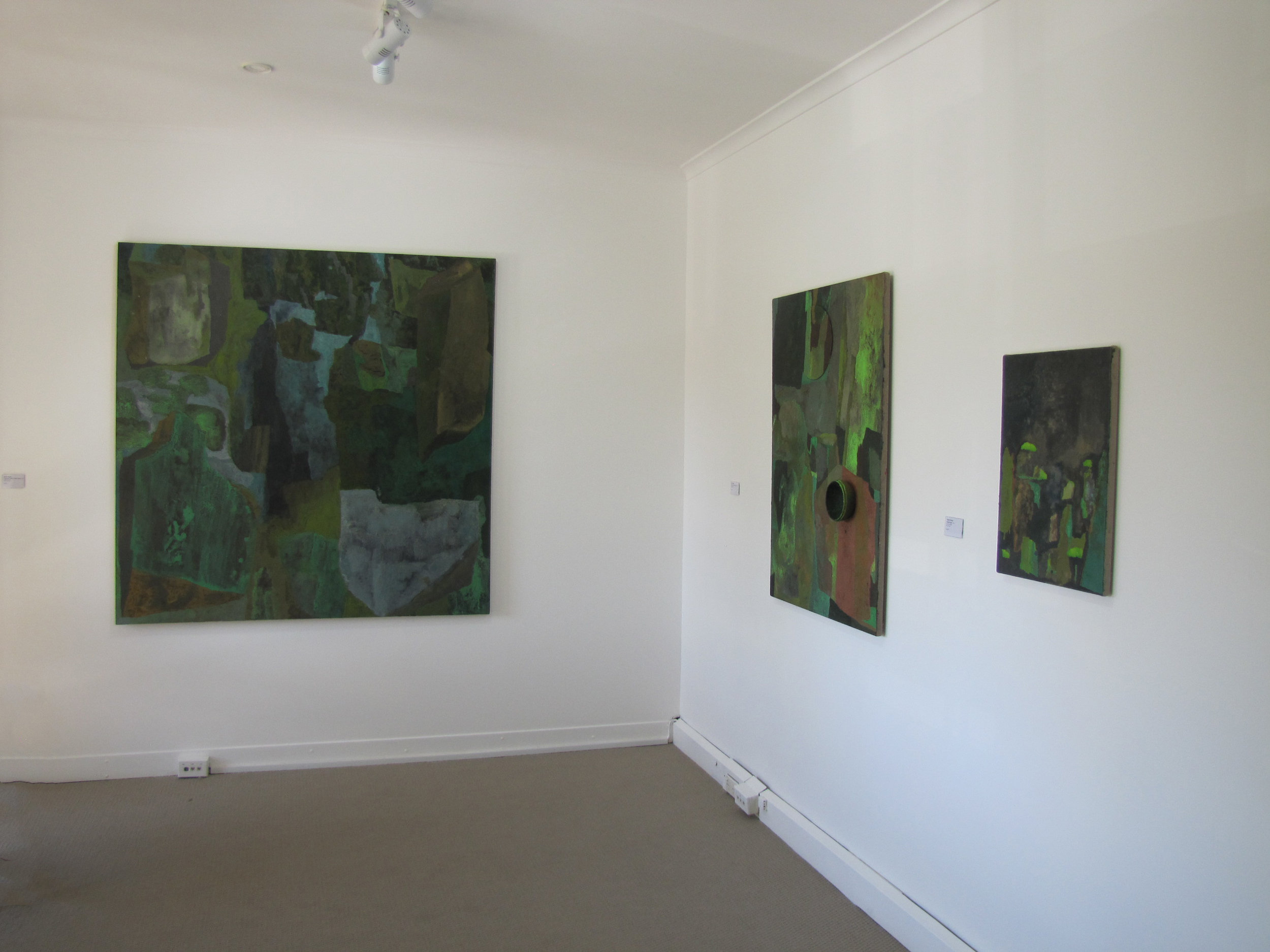

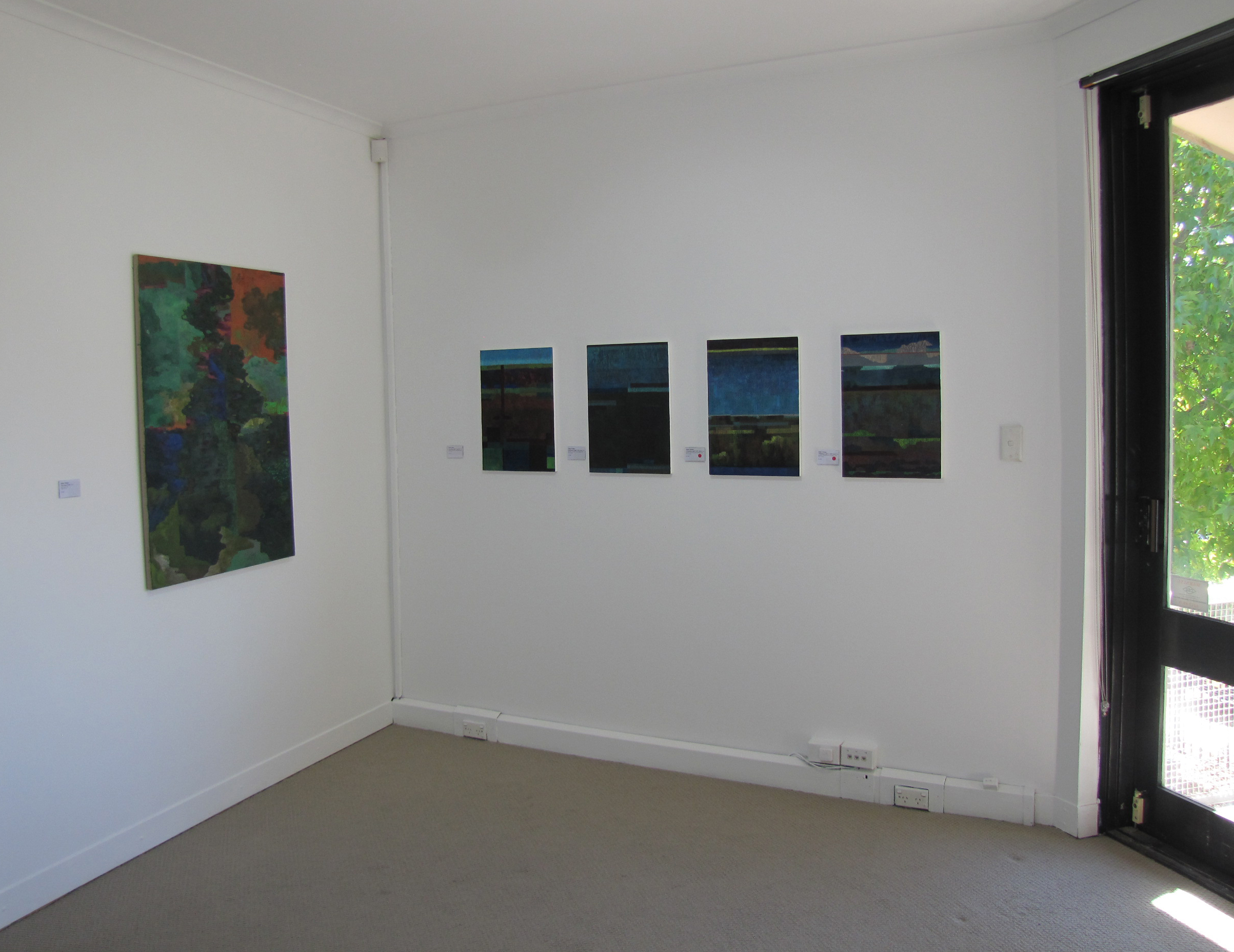
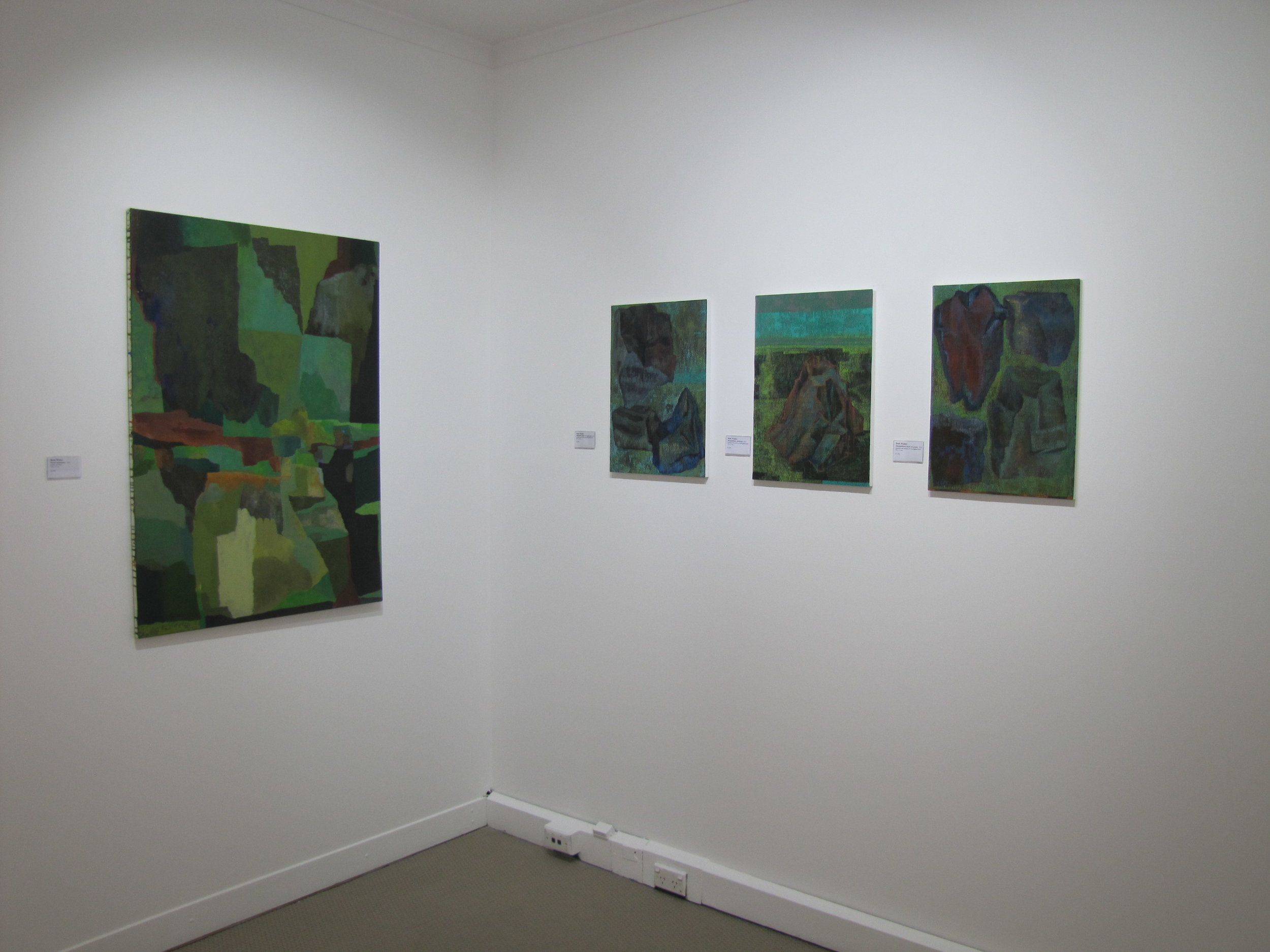
About the artist.
Ruth Waller was born in Sydney in 1955. She has taught Painting at ANU since 1990 and is currently Head of Painting. Waller has exhibited her work in Australia for over thirty years, in solo and group shows, and is represented in national, state and regional collections.
Her early work demonstrated a strong interest in the natural world, in eco-systems in danger, in undervalued, invisible and unseen life forms. In the 1990s her focus shifted towards exploring the act of seeing in painting, and the changing approaches to representation over painting’s history. Early Italian and Northern Renaissance art provided rich source material for several series of layered and reflective paintings, which addressed contemporary and personal subjects.
In 2000 her Masters thesis, Miraculous scenes from the altarpieces of Siena and Florence of the 14th and 15th centuries, reflected a long-term interest in the pre-Renaissance approach to pictorial space and composition. Since then, her painting practice has continued to explore ways of drawing on the early history of Western painting in developing works which reflect on contemporary experience and questions of perception, optics and the relations between mind and body in the creative process. In considering painting as a form of speculative research she is concerned to highlight the material and perceptual specificity of the conditions of painting, both for the maker and the viewer.
Most recently Waller has returned to exploring the natural world through painting, specifically the botany and geology of her own garden and of the local bushland. She speaks of finding new pleasures and possibilities in considering paint as a kind of mineral matter: of colour as a gritty and particular substance, enjoying the way rocks form and cleave with planar geometry and yet erode and crumble in ways more organic, each being irregular and unique and shaped by a specific series of events in the world.
“While I am working from nature, I’m interested in the ways the intensity of colours, patterns and forms of the natural world can take on a fantastic quality.” says the artist. “These paintings are in a sense abstracted from nature but they have something of the physicality and complexity of incident you find in historical narrative or landscape painting, where there is a lot going on. The fact is, when you look at the complexity and variety of things around us, there is a lot going on.”
Ruth Waller | Biographical details
Born Sydney 15. 11. 1955.
Education
2000 Masters of Arts by Research- Visual, (Art Theory) School of Art ANU
1974 - 1978 Studied Alexander Mackie CAE School of Art; Awarded Diploma of Art
Employment
2018- present Honorary Associate Professor, ANU School of Art & Design
2006-2018 Associate Professor, Head of Painting, ANU School of Art
1990-2006 Full time Lecturer in Painting at ANU School of Art, Canberra.
1985-1990 Part-time lecturer in Painting, East Sydney Technical College
1985-1990 Part-time lecturer in design, Art Workshop, Sydney University
1979-1987 Part-time lecturer in special programmes in TAFE
Academic awards
2013 International Women’s Day Certificate of Recognition (PARSA award)
2009 ANU Vice-Chancellor’s Award for Supervision
2008 ANU College of Arts & Social Sciences Award for Supervision
Art Awards
Canberra Critics Circle “Visual Artist of the Year Award 2010”
Solo Exhibitions
2022 Growing Things, Rogue Gallery, Sydney
2017 Vegetable, mineral…. Nancy Sever Gallery, Canberra
2017 Green like Suomenlinna, Watters Gallery, Sydney
2014 All that is solid, Nancy Sever Gallery, Canberra
2014 Mineral, Watters Gallery, Sydney
2012 Paintings 2011-12, Watters Gallery, Sydney
2010 Twenty-ten, Watters Gallery, Sydney
2010 Ruth Waller, a thirty-year survey, Maitland Regional Gallery
2010 Ruth Waller, a thirty-year survey, Canberra Museum and Gallery
2009 (painting), Helen Maxwell Gallery, Canberra
2008 The new paintings, Watters Gallery, Sydney
2007 Slime moulds/hotel suite: some paintings from the 90s, Watters Gallery
2006 Garbage Suite, Helen Maxwell Gallery, Canberra
2005 Paintings after lamentations from the low countries, Watters Gallery
2003 Recent work Watters Gallery, Sydney
2001 Sackbutts and crumhorns, Bellas Gallery, Brisbane
2000 Painting Watters Gallery, Sydney
1998 Adventures in misadventure, Tin Sheds Gallery, Sydney University
1996-7Paintings, Watters Gallery Sydney and at AGOG Gallery, Canberra
1996 Another room, another bed, Watters Gallery Sydney
1995 Another room, another bed, Canberra Contemporary Art Space
1994 E 11 North - The Hospital Paintings, Watters Gallery, Sydney
Deep Time In A Brand New Kitchen, 24 Hour Art, Darwin. N.T. and at Savode Gallery, Brisbane
1993 Deep Time in a Brand New Kitchen - Works on paper, Artspace, Adelaide Festival Centre
1992 Slime Moulds and Other Lives, AGOG, Canberra
1991 UnNatural History Paintings, Watters Gallery, Sydney
1989 Landscapes of Loss, Tin Sheds Gallery, Sydney
1988 Colony, Watters Gallery, Sydney
1985-6House About Wollongong, Wollongong City Gallery, toured to Photo-Access Gallery, Canberra, Experimental Art Foundation, Adelaide
Hibakusha/Disappeared, Watters Gallery,Sydney
1982-3 Remote Control, toured to Adelaide CAS ; Trades Hall Gallery Melbourne; Artspace Sydney
1982 Drawing & Posters, Watters Gallery, Sydney
1981 Remote Control, montage and posters, Watters Gallery, Sydney
Curated and Group Exhibitions
2022 Resistance, M16 Gallery, ACT
2021 Wild gardens and local bush, Rosny Schoolhouse Gallery, Hobart
2020 Flow Line: abstraction from the CMAG collection, Canberra Museum & Gallery
2019 Geo: Art of the Collection, ANU School of Art & Design Gallery
2018 Earth/Sky, National Gallery of Australia, Canberra
2018 Painting Amongst Other Things, ANU School of Art & Design Gallery
2017 Backyards, Mayspace, Sydney
2017 A decolonial geographic, Devonport Regional Gallery, Tasmania
2015 Encounter & Immersion: a dual exhibition by Denise Ferris & Ruth Waller,
Yo-Chang Arts Museum, National Taiwan University of Arts
2014 Monuments to the Frontier Wars, Damien Minton Gallery, Sydney
2014 Insight Radical, RiAus FutureSpace Gallery, The Science Exchange, Adelaide
2013 Insight Radical, Mclemoi Gallery, Sydney
2013 Insight Radical, Griffin Gallery, London, UK;
2013 Intensity of purpose, Canberra Museum & Gallery
2012 Theatre of the World, Museum of Old & New Art, Hobart, Tas, curated by Jen-Hubert Martin
2012 Word of Mouth: encounters with abstract art, Canberra Museum & Gallery, curated by Mark Bayly
2011 A Gleam of Light, M16 Gallery, ACT curated by Helen Maxwell
2011 2x4 @ M16, M16 Gallery, Canberra
2011 Imitation of life, Canberra Museum & Gallery
2010 Kedumba Drawing Award exhibition, Wentworth Falls NSW
2009 Making it new, Focus on Australian contemporary art, MCA, Sydney, curated by Glenn Barkly
2008 A Country Show, ANU School of Art Foyer
2008 Melbourne Art Fair- Watters Gallery exhibit
2007 Artists as Social Commentators, Manly Art Gallery& Museum curated by Therese Kenyon
2007 Myself by myself, Helen Maxwell Gallery
2007 In the Fold, ANCA Gallery ACT
2007 Recent acquisitions, Canberra Museum & Gallery
2006 Someone shows something to someone Canberra Contemporary Artspace
2005 The Body National Gallery of Australia
2004 Point to Line and Plane Tin Sheds Gallery, Sydney University
2003 Big Art, small viewer University of Queensland Art Gallery
2003 Collaborations Canberra School of Art Gallery
2001 Canberra Art Prize exhibition, Canberra
Coincidence, Spiral Arm Gallery, Canberra
1999 Natural Disasters, Monash University Gallery, Melbourne
The Redlands Westpac Art Prize Exhibition, Sydney
1998 The Kedumba Drawing Award Exhibition, Leura, NSW
Stone Fruits, AGOG, Canberra
1997 The McCaughey Prize Exhibition, National Gallery of Victoria
1996 Winter Light, AGOG, Canberra
1995 Recent Acquisitions, Queensland Art Gallery
Women in the collection, National Gallery of Australia
1993-4Identities- Art from Australia, TaipeiFine Arts Museum
1992 Medium Density- recent acquisitions, National Gallery of Australia
1990 Adelaide Biennale of Australian Art, ArtGallery of South Australia
Prizes
1990 Maitland Art Award
1990 Gold Coast Art Award
1989 Faber-Castell Drawing Prize
1989 Lake Macquarie Drawing Prize
External Grants
2015 Australia Council International Residency, HIAP studios Helsinki, Finland
2000 Australia Council Visual Arts Board residency- Barcelona studio
Arts ACT Fellowship to develop a series of paintings
FRGS Small Grant for travel to Europe to study late Flemish altarpieces
1998 PEP grant to research teaching of painting in tertiary art schools in Sydney, Melbourne, Hobart, Adelaide
1998 Australian Research CouncilFRGS Small Grant for field trip to Italy
1989 Australia Council Visual Arts Board Studio Residency- Verdaccio studio
1988 Australia Council Visual Arts Board project grant
1985 Australia Council Visual Arts Board project grant
ANU Internal Grants
2018 RSHA External Visitors Grant : Megan Walch (TAS)
2017 RSHA External Visitors Grant : Eleanor Ray (USA)
2015 RSHA External Visitors Grant : Andrzej Zielinski (USA)
2014 RSHA External Visitors Grant: bringing four interstate artists (Ross Manning, David Thomas, Geoff Newton, Nell) to contribute to our festival of Art & Music in conjunction with the Drill Hall Gallery Colour Music exhibition
2014 RSHA External Visitors Grant: Chinese lantern makers Cao Zhenrong & Cao Hong to conduct traditional lantern-making workshops in conjunction with the ANU Centre for China in the World.
2013 RSHA External Visitors Grant: Ecuadorean Environmental artist, Pablo Cardoso to run specialist workshops and seminars (due to unforeseen circumstances Cardoso cancelled)
2012 RSHA External Visitors Grant: Pakistani artist, Nida Bangash to run specialist miniature painting workshops and produce an artist’s book
2011 CASS Conference Grant toward Painting Symposium: Painting now: what happens when figurations and abstraction collide? ($5,000-)
Lectures, articles, conference papers
2017 ACUADS Conference paper: The price of bananas: a painter’s perspective
2016 AAANZ Panel convenor: What is a painting?
2014 Miraculous scenes from the altarpieces of Siena and Florence of the fourteenth and fifteenth centuries (extract, Ruth Waller: Masters of Arts (Visual) ANU School of Art 1999, in Artists with PhDs: On the new doctoral degree in studio art, (Second edition) ed. Elkins,James,
2013 Panel member Judgement Calls forum Museum of Contemporary Art, Sydney
2012 To paraphrase Richard Hamilton, Just what is it that makes today’s abstract painting so different, so appealing? Conference paper delivered at the AAANZ conference, Sydney University
2012 Abstraction Now: on-the-artist-formally-known-as-abstract,(catalogue essay) Volume One, Towards a new MCA, MCA Collection catalogue, p. 67
2011 Creativity: mind, brain & body: introductory address for panel discussion of keynote speakers Iain McGilchrist and Ross Gibson at the ACUADS conference, ANU School of Art
2010 This Way Up: catalogue essay for This Way Up: an exhibition series of recent abstract painting, ANU School of Art ISBN 978-0-7315-3069-4
2009 Miraculous scenes from the altarpieces of Siena and Florence of the fourteenth and fifteenth centuries (extract), Ruth Waller: Masters of Arts (Visual) ANU School of Art 1999, in Artists with PhDs: On the new doctoral degree in studio art, pp.211-225, ed. Elkins,James, Washington, 2009
2007 On practice-led research (and the banana problem) : paper presented at Can bad art be good research? seminar, RSH, ANU
Creative research- arguing for abstract painting: paper at ANU School of Art/UCAN joint symposium on creative research
2005 Gone tomorrow, catalogue essay for exhibition by Peter Maloney, Canberra Museum and Gallery
2004 Dulle Griet and global glut, conference paper for ANU School of Humanities conference, Art & Excess
2002 Catalogue essay: Snap! Painting showcase exhibition, ANU NITA, School of Art publication
2002 Lecture: Dying for it: painting and martyrdom at National Gallery of Australia, in conjunction with Three Centuries of Italian Art
2001 Conference paper: From Van Eyck to virtual, presented at Seeing Art and the Art of Seeing Conference Centre for Visual Science, ANU
2001 Lecture: Lessons from art history in the development of my studio practice to the NSW Southern region Art Teachers Conference
Recent articles, catalogue entries, reproductions and reviews in journals and online including :
Powerhouse Museum D*Hub, (Orsini, Rita) http://www.dhub.org/where-science-meets-art/
Raven: a platform for contemporary art and events
https://www.ravencontemporary.com.au/exhibitions/insight-radical/
Sydney University Faculty of Science, Inspiring Australia, Randles, Jackie,
http://sydney.edu.au/science/outreach/inspiring/news/insight-radical.shtml
University of Melbourne, Faculty of Science, Dr Renee Beale http://sciencematters.unimelb.edu.au/2012/08/insight-radical-where-science-meets-art/
Artist Profile, Craven, Owen, Insight Radical: where science meets art, Issue 23, 2013
Artist Profile, (Craven, Owen, Profile: Ruth Waller) Issue 14, 2011 pp.70-5
Making it New, Focus on Contemporary Australian Art, MCA Sydney catalogue,(Isabel Hesketh: Ruth Waller) pp.146-155
Art Monthly Australia, (Broker, David, Power of two: Ruth Waller & Jude Rae) Issue 231, July 2010
Artlink (McFarlane, Jenny, Ruth Waller A 30 year survey) vol 30 no.2, 2010
Art Monthly Australia, (Geczy,Adam, Making it new) pp.13-15 Issue 227, March 2010
Canberra Times, (Grishin, Sasha, Play of light and shadow, p.9, Dec 8 2009
Artlink(Joanna Mendelsohn, review of Recent Work, 2003)
SydneyMorning Herald (Bruce James, review of Recent Work, April 23, 2003)
Canberra Times (Sonia Barron, review of Coincidence, June 2001)
Sydney Morning Herald (Bruce James, Sights, City File March 25, 2000)
Sydney Morning Herald (Courtney Kidd, Another time and space, March 21, 2000)
Art link (Image Bank p.50, Vol 17/2, 1997)
The Canberra Times (Sasha Grishin, Delicate magic of pawscapes, 19 October, 1996)
The Australian (Joanna Mendelssohn, Sydney Art, 16 February 1995)
The Age (Bruce James, Low Rent Elegance, 21 February 1995)
Art Monthly (Deborah Clark, Blue Angels, Number 73, Sept.1994)
Artfan (Ewington, Ferran, Skuse, McCaughan, Ell North,The Hospital Paintings, Spring 1994)
Work cited in publications including:
Australian Contemporary Drawing- Arthur MacIntyre;
1990 Adelaide Biennale of Australian Art catalogue - Mary Eagle
Sightlines- Sandy Kirby
Seeing Australia- Graeme Sullivan
Identities- Art from Australia catalogue - Deborah Hart
Art Now- Contemporary Art post 1970 - Williams and Simpson
Works held in Public Collections
Major National & State Collections:
National Gallery of Australia; National Gallery of Victoria ; Art Gallery of NSW; Art Gallery of Queensland; Artbank,
Regional Gallery Collections:
Wollongong City Gallery; New England Regional Art Museum; Ballarat City Gallery; Warnambool Gallery; Manly Art Gallery & Museum; Maitland Regional Gallery; Lake Macquarie Regional Gallery; Gold Coast Regional Art Gallery; Canberra Museum & Gallery;
University Collections: University Art Museum, University of Queensland; Sydney University Student Union Collection; ANU School of Art Collection; Monash University Collection; University of Canberra Art Collection; ANU Art Collection; Griffith University Gallery
RUTH WALLER | ALL THAT IS SOLID
3 SEPTEMBER - 5 OCTOBER 2014
Artist's statement
These paintings grew out of a number of everyday visual pleasures: a collection of small rocks picked up the bush, plants my backyard garden, the landforms of the Blue Mountains, mornings spent amongst the eucalypts in the Canberra Botanic Gardens, and the pleasures of painting itself, of Bellini, El Greco, Gauguin, of Romanesque frescoes and Indian miniatures. The process of making them was a much more instinctive and improvisatory thing than I have experienced before, listening to Miles Davis, John Coltrane and Charles Mingus. Maybe as a result these paintings look a bit retro- a bit 1950s.
Recently I have found myself enjoying the experience of considering paint as a kind of mineral matter: of colour as a gritty and particular substance. And I enjoy the way rocks form and cleave with planar geometry and yet erode and crumble in ways more organic. Each is irregular and unique and is shaped by a specific series of events in the world.
I know these works are pretty complex and dense. A lot of recent abstract painting is pretty spare and clean, but I figured I'd like to make work that has the physicality and complexity of incident you find in historical narrative or landscape painting, where there is a lot going on, often on a relatively modest sized canvas. The fact is, when you look at things, there is a lot going on.
I think it's hard to make any great claims for painting today. It is something of a curious anachronism. I like that. it's really quite releasing to be consigned to irrelevance, to be out of sync with things. It means you can just get on with making your work, reinventing things for yourself and you can be quite idiosyncratic about how you do it.
Works included in the exhibition RUTH WALLER| ALL THAT IS SOLID
(for details of the works, please click on work and hold cursor over the image)
views of the exhibition

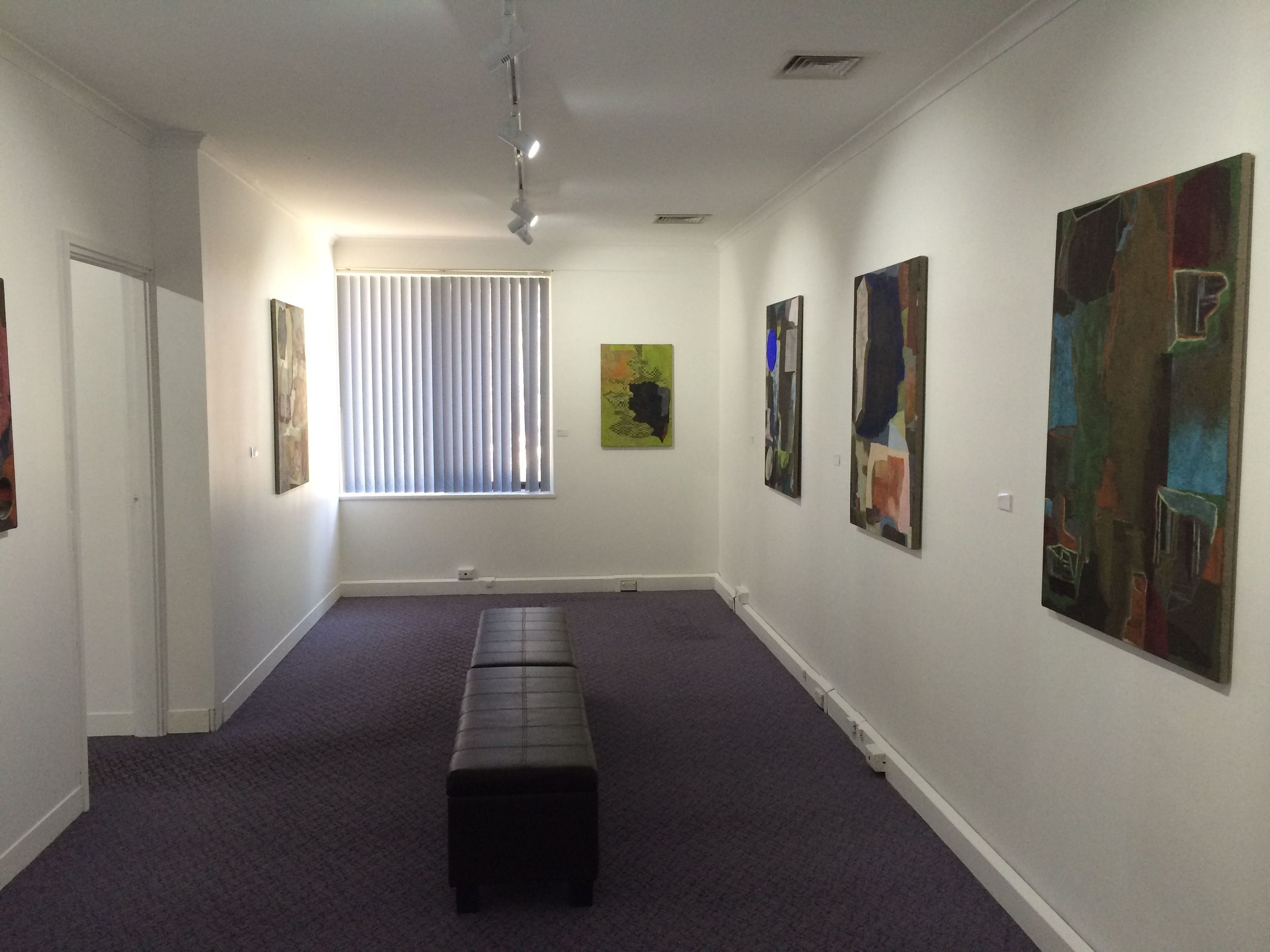
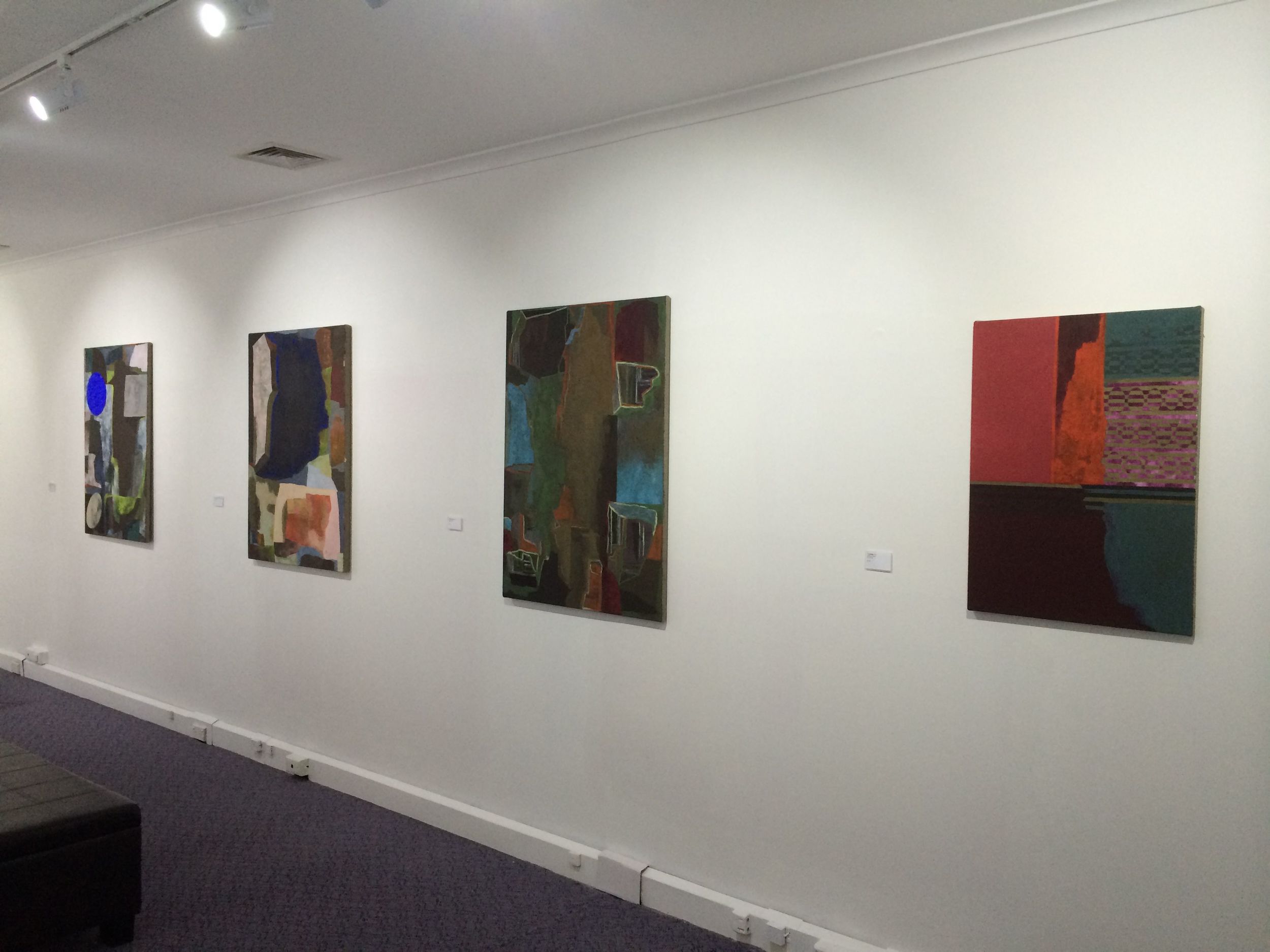

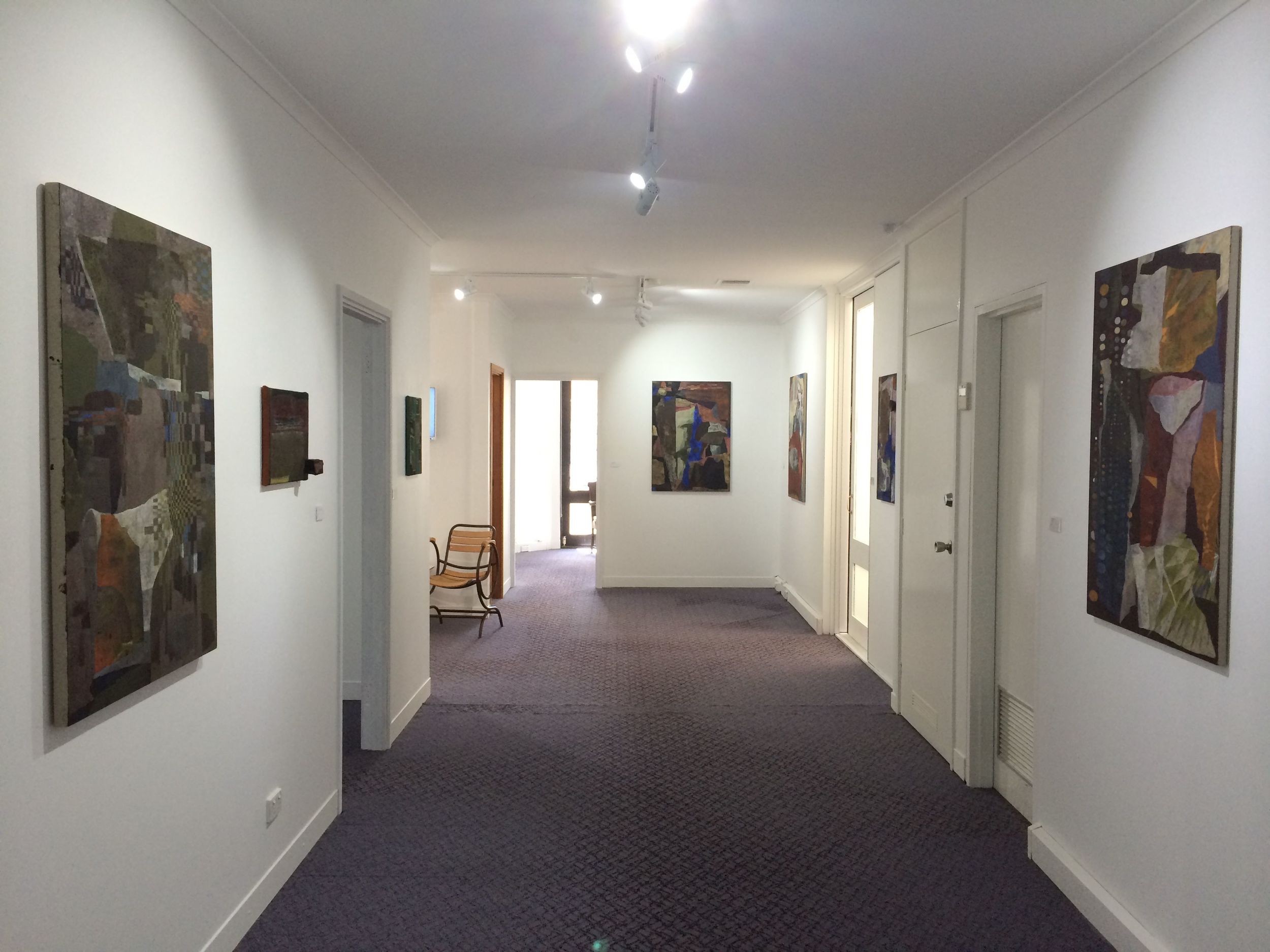

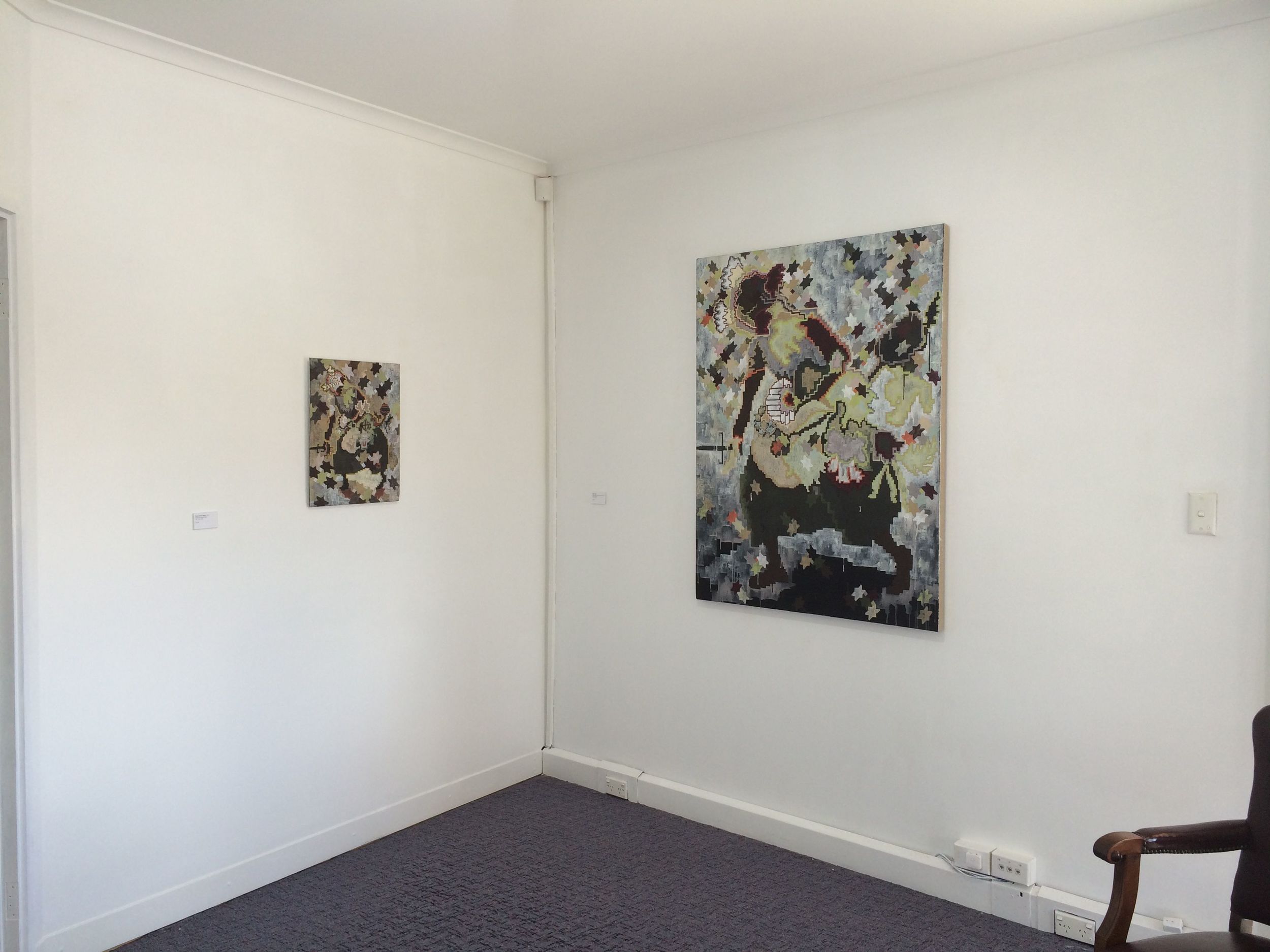
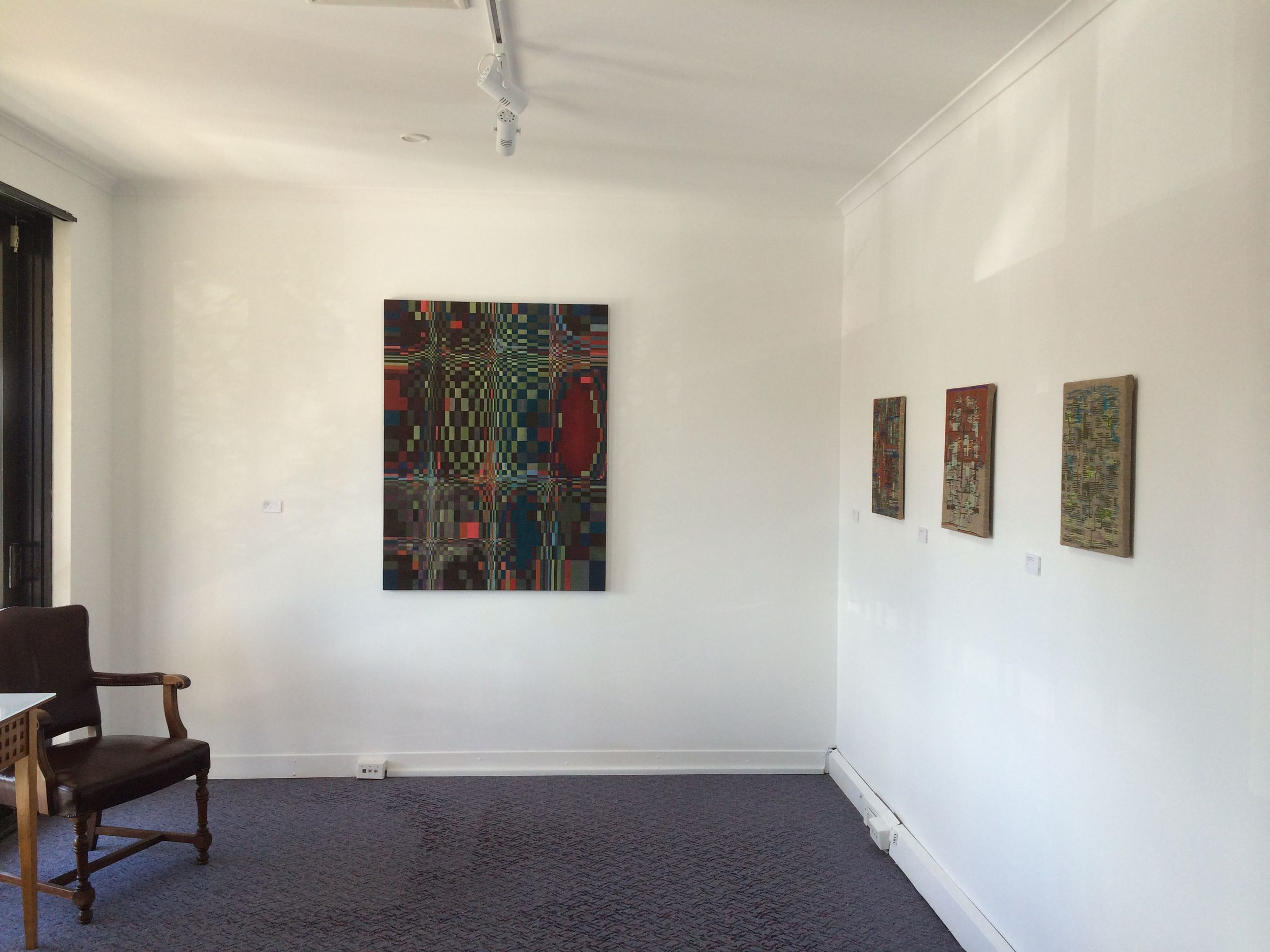
About the artist.
Ruth Waller was born in Sydney in 1955. She has taught Painting at ANU since 1990 and is currently Head of Painting. Waller has exhibited her work in Australia for over thirty years, in solo and group shows, and is represented in national, state and regional collections.
Her early work demonstrated a strong interest in the natural world, in eco-systems in danger, in undervalued, invisible and unseen life forms. In the 1990s her focus shifted towards exploring the act of seeing in painting, and the changing approaches to representation over painting’s history. Early Italian and Northern Renaissance art provided rich source material for several series of layered and reflective paintings, which addressed contemporary and personal subjects.
In 2000 her Masters thesis, Miraculous scenes from the altarpieces of Siena and Florence of the 14th and 15th centuries, reflected a long-term interest in the pre-Renaissance approach to pictorial space and composition. Since then, her painting practice has continued to explore ways of drawing on the early history of Western painting in developing works which reflect on contemporary experience and questions of perception, optics and the relations between mind and body in the creative process. In considering painting as a form of speculative research she is concerned to highlight the material and perceptual specificity of the conditions of painting, both for the maker and the viewer.
Most recently Waller has returned to exploring the natural world through painting, specifically the botany and geology of her own garden and of the local bushland. She speaks of finding new pleasures and possibilities in considering paint as a kind of mineral matter: of colour as a gritty and particular substance, enjoying the way rocks form and cleave with planar geometry and yet erode and crumble in ways more organic, each being irregular and unique and shaped by a specific series of events in the world.
“While I am working from nature, I’m interested in the ways the intensity of colours, patterns and forms of the natural world can take on a fantastic quality.” says the artist. “These paintings are in a sense abstracted from nature but they have something of the physicality and complexity of incident you find in historical narrative or landscape painting, where there is a lot going on. The fact is, when you look at the complexity and variety of things around us, there is a lot going on.”
Extracts of Reviews and Writings.
Waller’s intellectual and aesthetic reach in drawing on the subjects and visual organisation of Renaissance painting extends to the incorporation of contemporary themes in her work. Environmental issues, chaos and civilisation, permanence and transience, conflict and harmony are all invoked by her intriguing paintings. And in their references to the history of painting and the act of seeing, the artist confirms the centrality of the practice of painting as a carrier of multiple – including contemporary – meanings.
ACT Museum and Gallery
__________________________________________________________________
Ruth Waller's studio (11 Mar 2013)
“One woman makes a din, two women a lot of trouble, three an annual market, four a quarrel, five an army, and against six the Devil himself has no weapon.” Book of Proverbs, Antwerp, 1568.
I was fascinated as she provided insight into what had inspired the pieces she is working on for the Insight Radical project. I have come to learn that Ruth is particularly skilled in giving words to essentially mental processes that many of us would find very difficult to explain.
She began by warning me that it all might sound rather strange and crazy, and that I might wonder what it all had to do with these molecules we call free radicals. She confided that she would never be able to completely understand the science behind free radicals but that she could contribute to how we might think about them by adding another dimension to the dialogue.
During the residency Ruth was interested in the patterns and chain reactions relating to free radicals but wasn’t sure how she would tackle the subject in real terms.
As we stood in her studio she explained how she had returned to a figure she had explored in some of her previous work, Dulle Griet (Dull Gret), and drew parallels between her research on Dulle Griet and what she learnt about free radicals whilst on residency.
The subject of a 1562 painting by Flemish renaissance artist Pieter Brugel the Elder, Dulle Griet also known as Mad Meg, is a figure in Flemish folklore. The painting depicts a peasant woman who leads an army of women to pillage Hell despite already being burdened with many possessions. Hence the following Flemish proverb “She could plunder in front of hell and return unscathed.”
Owen Craven
_________________________________________________________________
Ruth Waller.
It seems almost contrarian, at a time when fashionable taste looks towards the postcolonial and eschews the western tradition, for an artist in Australia to explore the depths and the implications of the northern Renaissance. But in recent years Ruth Waller has done just that.
Of course being Waller, the painter of past pawscapes, her art is far removed from the pretty geometry of Jeffrey Smart or Justin O'Brien. These explorations have an edge, a sense of a world not quite comfortable with itself and its history. Her 'texts', if that is the right word, are Breughel's painting, Dulle Griet (Mad Meg) and Dieric Bouts' The Martyrdom of St Erasmus. There are lyrically beautiful abstract forms making patterns of rhythms - a series appropriately named Sackbutts and Crumhorns. These are more than simple visualisations of medieval popular music. They also celebrate form and line in harmony, visual counterpoint creating music for a time long past, that is also like the present age in its confusion, disruption and intolerance.
The strongest sense of this world of confusion comes from her Dull Griet series, based on Breughel's painting of a mad woman in the face of war. Although this painting has been celebrated as a 'modern' depiction of lunacy, it is clear that Breughel saw her as a creature from 'the Gates of Hell' through which she passes in urgency and lunacy. Waller then is going to the heart of the western tradition that has women carry the burden of madness caused by war. Her Mad Meg is made of the rubbish she carries, a bleak creature of destruction, almost robot-like as she progresses without feeling in a mechanistic world. She is a woman-machine, out of control avenging as well as despairing, the ultimate being of our modern age who also belongs visually and intellectually to the angst of the past. Then there are the skips - elegant shapes in which rubbish may be placed. Waller first saw these skips when she was living in Barcelona on an Australia Council residency and was impressed by their beauty, and the way in which they become the holding place for fragments of people's lives.
The key to this series is one of the smallest works in the exhibition, Deposition. Waller has always been intrigued by the women tenderly taking the dead Christ from the Cross, where emotion and grieving is shown by the fold of the cloth, the angle of the corpse, the bowed heads of the mourners. This Deposition is however different. It is a collection of rubbish in a skip, so arranged that at first the images appear to be valuable relics of the western tradition, but in a skip everything is reduced to rubbish. Other paintings expand the theme - arches and crosses, odd shapes that have double meanings - the structure of western culture, turned into trash. The skip paintings also link to small sculptures on the same subject matter, where the artist plays with the geometry of apparent rubbish. These may have been developed as tools to help her work through her ideas for the two dimensional works, but they stand as small intriguing sculptures in their own right. Waller has made other sculptures. Waller's Dulle Greit first saw light of day as two sculptures, and it was these metre high rough unfinished works that later had their portraits panted to make the series.
Breughel's Dulle Griet has been described as his greatest work, his personal critique on the folly and barbarism of the Spanish Inquisition, but Waller's other visual 'text' is perhaps less famous. This is Dieric Bouts, The Martyrdom of St Erasmus. For those of us with a secular base, Erasmus is the great Dutch Renaissance philosopher, but the saint, his namesake had a bloodier context. He is usually painted being disembowelled (he is the patron saint of women in labour), and was popular in both the northern and the Italianate tradition. Waller admires most the Flemish tradition, the way the artists invite the viewer to join them in the picture plane.
Bouts' St Erasmus lies there as his intestines are wound up on a winch while the saint, and his torturers, look on in relative tranquillity. In St Erasmsus and the Painting Machine Waller uses the structure of Bouts' painting and the winch to show the miracle of the pictorial space and an investigation of pictorial structure. It is all there on a frame (which looks remarkably like a loom), a construction beautifully painted and gradually dissolving into geometry. It is such a pleasure to see paintings well made and thoughtful, where theoretical considerations harmonise with visual concerns instead of illustrating them.
Ruth Waller interviewed by Joanna MendelssohnArtlink, Vol.23, No.2, 2003.



